BOULEVARD
New developments on Larchmont. At right, The Scent Room. Page 6


















MUSEUMS Construction continues at LACMA new galleries above park and Wilshire Boulevard. Page 12

WORD CAFÉ
Taking a trip through The Met’s magical medieval world.
Page 15

HANCOCK PARK • WINDSOR SQUARE • FREMONT PLACE • GREATER WILSHIRE • MIRACLE MILE • PARK LA BREA • LARCHMONT
©2023 Coldwell Banker. All Rights Reserved. Coldwell Banker and the Coldwell Banker logos are trademarks of Coldwell Banker Real Estate LLC. The Coldwell Banker® System is comprised of company owned offices which are owned by a subsidiary of Anywhere Advisors LLC and franchised offices which are independently owned and operated. The Coldwell Banker System fully supports the principles of the Fair Housing Act and the Equal Opportunity Act. CalRE #00616212 COLDWELLBANKERHOMES.COM Hancock Park 323.464.9272 | 251 N Larchmont Boulevard, Los Angeles, CA 90004 REDUCED! Stunning 2sty, Sound proofing dbl paned wndws. Renovated 6 bd/3 + fam rm. 3600s ft. Fab kitch. Cecille Cohen 213.810.9949 CalRE #00884530 356 S. Hudson Ave.| Hancock Park| $19,500,000 Lisa Hutchins 323.216.6938 CalRE #01018644 An Exquisite, Rare Gated Tennis Court Estate! 4 stories, 10 beds/14 baths, theater. By appt only. 120 N. Irving Blvd. | Hancock Park| $3,995,000 SOLD. Represented Buyers. fully updated Spanish-style home. 4 beds / 3 baths. Rick Llanos 323.810.0828 CalRE #01123101 330 S. Windsor Blvd. | Windsor Square | $6,299,000 SOLD. A+ location. 4 beds + 6 baths + office & full basement. Pool. 330SWindsor.com Loveland Carr Group 323.460.7606 CalRE #01467820, 0888374 Location, Location, Location. 1930’s bungalow, 3 beds, 3.5 baths, hillside views. Large windows and balcony. Rick Llanos 323.810.0828 CalRE #01123101 1736 Westerly Terr| Silver Lake | $1,549,000 211 S. Citrus Ave. | Hancock Park| $2,899,000 Lisa Hutchins 323.216.6938 CalRE #01018644 Sought after block! 2 story Medit., RARE 5bed/3 bath, pool/spa, huge family room! 437 N. Windsor Blvd. | Hancock Park| $2,499,000 Lisa Hutchins 323.216.6938 CalRE #01018644 Super Sharp 4 bed / 3 New baths, sleek kitchen. 2 story entry & living room. 145 S. Hudson Ave. | Hancock Park | $20,000/MO Stately English on one of the finest blocks in Hancock Park. 6 beds + 5.5 baths, pool w/ spa. Rick Llanos 323.810.0828 CalRE #01123101 Kristen Tostado 323.206.0280 CalRE #02203805 1645 Vine St. #703| Hollywood | $850,000 Glamorous historic Hollywood loft. Rooftop pool/ cabanas/gym. Full service. Walk-in closet. Barbara Allen 323.610.1781 CalRE #01487763 578 N. Gower St. | Hancock Park | $1,920,000 A rare 5bds 3bth home in 2040 Sq Ft A blk & a half from Paramount Studios and Larchmont Village Bob Day 323.821.4820 CalRE #00851770 449 S. Mansfield Ave. | Hancock Park| $1,989,000 Lisa Hutchins 323.216.6938 CalRE #01018644 IN ESCROW. Super Sharp & Sleek! Move right in! Sought after open plan! 4 Beds / 2.5 baths. 449 N Highland Ave. | Hancock Park | Coming Soon Character filled Spanish with 4 bdrms, 3.5 baths, den, playroom and sparkling pool. Call for Price Rick Llanos 323.810.0828 CalRE #01123101 LEASED. Furnished or unfurnished, short or long term. 5 beds, 5.5 bas including guest house & pool. Rick Llanos 323.810.0828 CalRE #01123101 160 N. McCadden Pl. | Hancock Park | $15,000/MO LEASED in one week. Stunning Spanish Home. 3 beds 4 baths. Living room w/ original gas fireplace. Rick Llanos 323.810.0828 CalRE #01123101 412 S. Citrus Ave. | Hancock Park | $8,500/MO Kristen Tostado 323.206.0280 CalRE #02203805 Loveland Carr Group 323.460.7606 CalRE #01467820, 0888374 LEASED. Represented Landlord. 1 Bd / 1.5 baths. 647 Wilcox Ave. #3E| Hancock Park | $850,000 Outstanding Golf Course Views. Spacious, light & wellpresented top-flr unit in HP Terrace. 1Bd / 1.5 baths. Shar Penfold 323.356.1311 CalRE #01510192 VIEW Real estate enteRtainment, museums Home & GaRden Section 2 LARCHMONT CHRONICLE SEPTEMBER 2023
Who really saved our local, historic Los Altos Apartments?
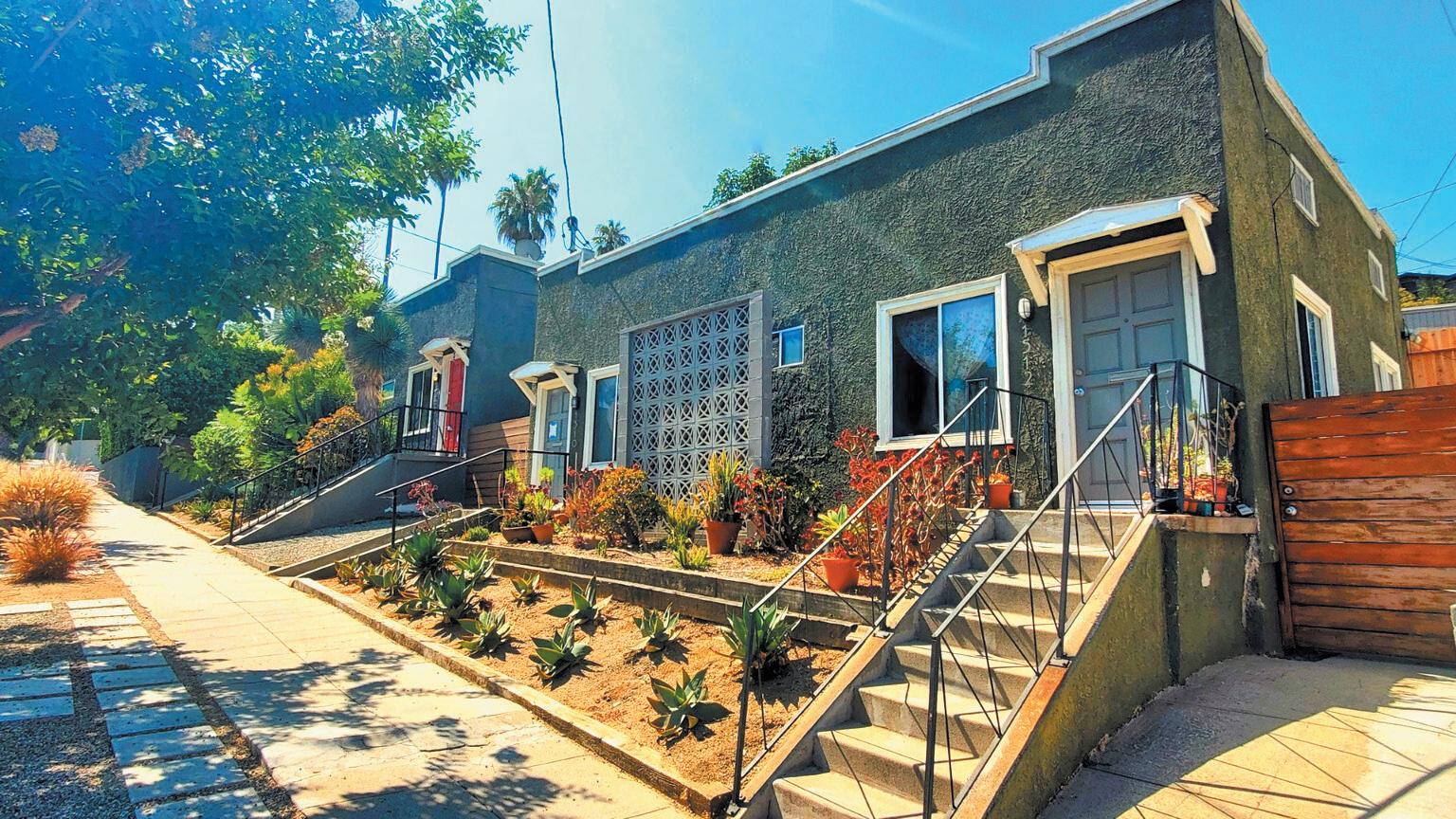


have to do with it?
And what did celebrity chef Nancy Silverton and Playboy Magazine
By Janet Lever
On a Saturday night in the spring of 1996, through thick synthetic fog, Playboy Playmate Shauna Sand was struggling to walk in her 4-inch heels on uneven cobblestones in the courtyard at the historic Los Altos Apartments at Wilshire Boulevard and Bronson Avenue. She was at the shoot for her Playmate video. Among the few observers allowed on site was actor Lorenzo Lamas, soon to be her husband. I was there, too, invited by my friend co-producer Marsha Hunt to share her dinner break in the lavish 3,300-square-foot, two-story suite designed by San Simeon Hearst Castle’s architect Julia Morgan as the “city flat” for William Randolph Hearst and Marion Davies. While Marsha ate, I had fun pushing on wood panels in the regal dining room with hopes one would spin open to reveal cash in a hiding place from an era with no ATMs.
Located at 4121 Wilshire Blvd. — and, since 1999, listed on the National Register of Historic Places — the Spanish Colonial-style 1925 building

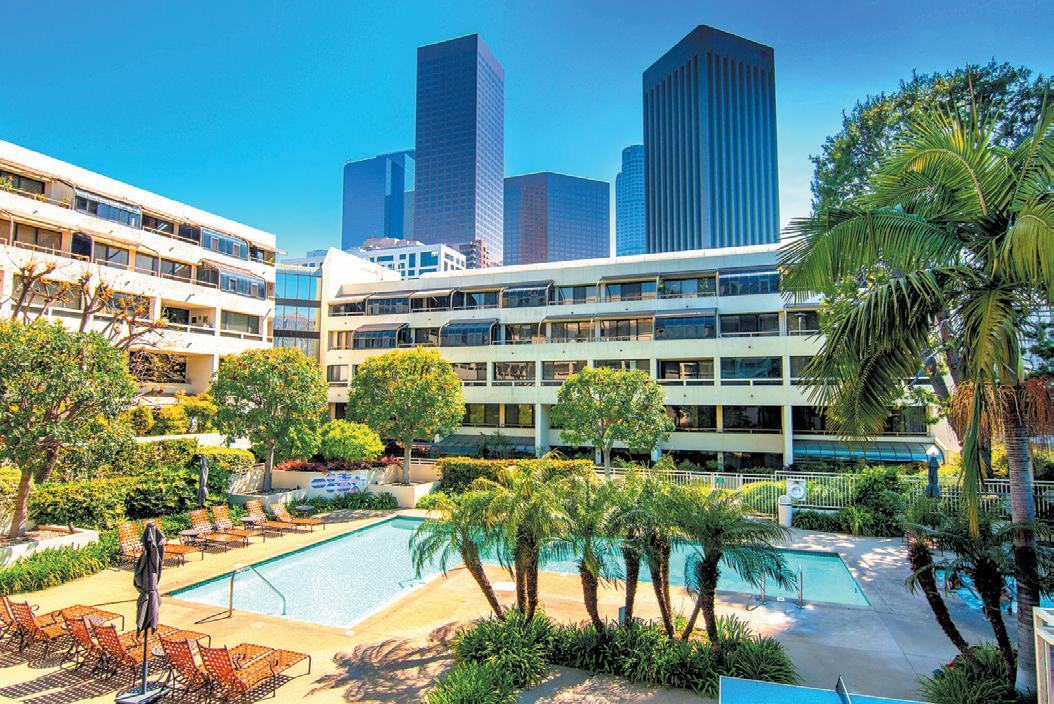
with its imposing neon rooftop sign has a checkered past. At the time of the film shoot it was empty — save for a caretaker’s apartment and, it was rumored, one hold-out last tenant, actor Frederick Forrest — after nearly all of its bohemian artist, writer and actor residents were evicted when a renovation failed in the late 1980s. As the first co-op building on the West Coast, its units had been custom designed for each owner, but the Great Depres-
sion bankrupted the building so it transitioned to luxury rental apartments. According to several sources, Los Altos boasted of Hollywood royalty residents like Bette Davis, Douglas Fairbanks and Judy Garland, who could be seen dining next door in the pink booths at legendary Perino’s. Virtually deserted, Los Altos and Perino’s in the 1980s had become popular location sites for film productions seeking iconic Los Angeles settings. Perino’s was torn down
in 2005 for a nondescript apartments project (that has salvaged Perino’s signage and some interiors).
Credit due
The near-vacant Los Altos was also doomed to demolition given the exorbitant price for seismic retrofitting and reversing its decades of decay and disrepair. Credit for saving and restoring this elegant representation of early-20th-century architecture has gone to nonprofit Neighborhood Effort’s Allen Gross
and Arax Harutunian and the M2A Milofsky Michaeli architecture firm. While they deserve their awards for historic preservation, they are not the ones who saved the building from obliteration. That person — entirely missing from the written record — was construction attorney Larry Silverton.
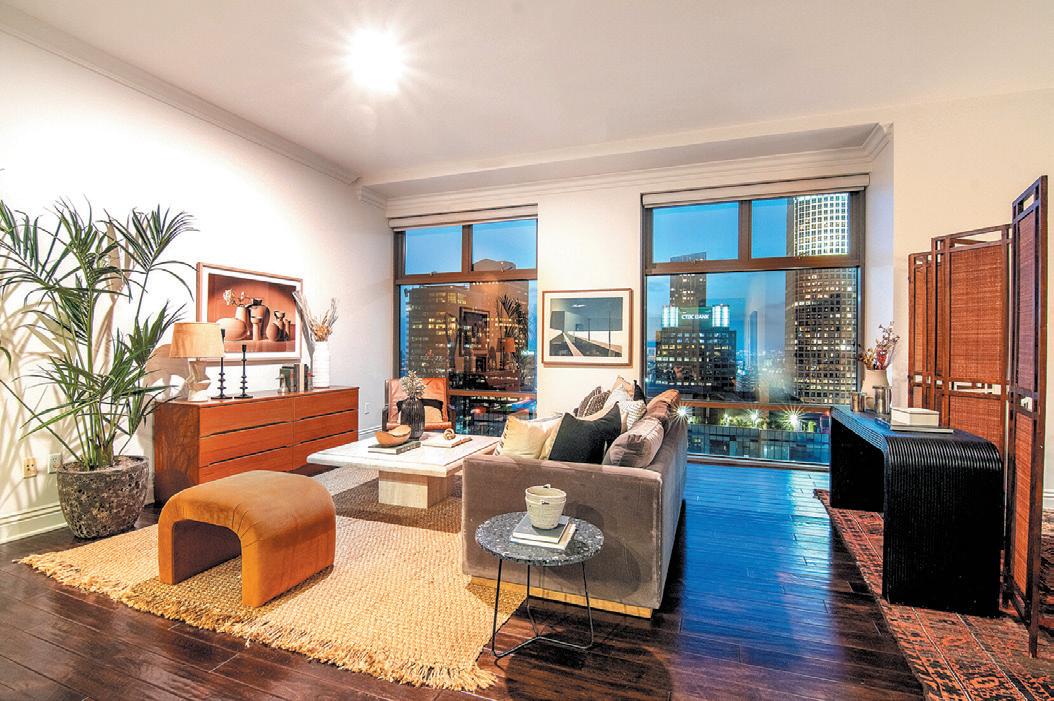
Larry Silverton was the same man who, in the late ’80s, renovated the decaying architectural mishmash (Moorish arches, Gothic tower and Spanish fountain) at 624 S. La Brea Ave., built in 1928 by Charlie Chaplin. Larry was on a search for a space for his daughter Nancy Silverton, today a resident of Windsor Square, and her cochef and then husband, the late Mark Peel, for their famed restaurant Campanile and Nancy’s adjacent original, La Brea Bakery. (The space currently is home to French café République.)

An internationally renowned chef (now operating Osteria Mozza, Pizzeria Mozza, and Chi Spacca locally), Nancy Silverton is perhaps most famous for popularizing artisan breads — La Brea Bakery breads are now sold in 22 countries.
(Please turn to page 3)
Expert Service. Exceptional Results.



639 Robinson|$2,995,000 6 Units | Silver Lake Pete Buonocore pete@coregroupla.com 323.762.2561 DRE #01279107 www.coregroupla.com DRE #01870534 121 S. Hope #10 |$688,000 1 Bed+2 Bath | Downtown LA 531 Wilcox| $16,000 Per Month 4 Bed+4 Bath| Hancock Park 801 S. Grand #2204 | $798,000 2 Bed+2 Bath| Downtown LA 1506 Scott Ave.| Price TBD 6 Units | Echo Park
For Sale New Price Coming Soon For Lease New Listing 301 Ashland |$7,500,000 9 Units| 13+13 |Santa Monica New Listing 2 SECTION TWO SEPTEMBER 2023 Larchmont Chronicle
LOS ALTOS APARTMENTS at the corner of Bronson Avenue and Wilshire Boulevard.
Los Altos

(Continued from page 2)
My involvement
How do I know who really saved the Los Altos? It’s like this: After a series of coincidences, I eventually got a small finder’s fee from Larry Silverton for leading him to the abandoned Los Altos Apartments. The same day I went to the Playboy shoot, my oldest friend, Pepper Schwartz, was meeting Larry Silverton in Seattle at a horse event. Pepper, now widely recognized as on-air relationship advisor on Lifetime’s show “Married at First Sight,” was coming to Los Angeles the next day, so Larry invited her to be his guest at Campanile for some of Nancy’s celebrated pastries and a glass of champagne. She said, yes, if she could bring me, her host in Larchmont Village. We met Nancy Silverton after the dinner crowd left and staff was getting ready to
close. Larry explained to us his part in restoring the dramatic dining room we were in. Learning that I lived in the neighborhood, Larry asked if I knew any historic buildings that might be for sale and in need of renovation.
Bingo! Larry couldn’t wait until the next day to see Los Altos Apartments, just five minutes away, and he therefore said we must go see it that late Sunday night. We wandered around in the dark outside the vacant building. All of us being short, we lifted each other to peer in the windows to see the grand lobby with its winding staircase, ornate pillars and oversized fireplace like the ones you see at Hearst Castle. Larry was smitten and said he’d immediately investigate any purchase opportunity.
Righting the record
The reason I feel the need to right the record on the salvation of the Los Altos property is not because Larry bought it first, later agreeing to sell it once he was convinced that the Neighborhood Effort team would more faithfully restore it to its original splendor. I want this story told because I firm-

ly believe no one else would have bought and reunited that building and its nextdoor historic garage, whose high wooden rafters reminded me of the hangar for the Spruce Goose. (The Los Altos tower and garage properties went to separate owners after WWII.) The rub: Larry quickly learned that there was hazardous subsurface methane gas under the garage. To prevent possible explosions, an expensive mitigation plan was
needed at an estimated cost from $25,000 up to millions — the engineers couldn’t determine the cost until they actually started the work.
Contrasting the enormous renovation price against any upside gain from apartment revenues, the whole deal was already iffy. Add the unknowable gas mitigation costs and daunting red tape, and most developers would run, not walk, away from the deal. But Larry Silverton was not an ordinary man. This would be his 20th restoration project since 1957. Providing insight into her late father’s motives, daughter Nancy told me, “Saving some of LA’s precious architectural history had become
his passion project. Besides, that man loved a challenge.” He took the gamble and bought both Los Altos and the parking garage. He was not just gutsy, but also lucky: The price to make the garage safe was close to the low end of the estimates.

I’m not sure of the circumstances of how the Neighborhood Effort team came to make Larry an offer and convince him that their nonprofit would make the better steward to bring Los Altos back to its glory days. Allen Gross is the owner today. But I know that Larry Silverton deserves recognition as the unsung hero whose brave actions were responsible for saving Los Altos from the wrecking ball, thus preserving its heritage for us all.
Janet Lever is a writer, sex researcher and professor emerita of sociology. She has lived in Larchmont Village since 1986.
 PERINO’S RESTAURANT circa 2004.
PERINO’S RESTAURANT circa 2004.
Larchmont Chronicle SEPTEMBER 2023 SECTION TWO 3
Photo © Terry Guy COURTYARD of Los Altos Apartments.
NANCY SILVERTON in 1991 at Campanile.
Photo by George Rose
Project bubbling at Beverly Hot Springs
n Artesian well to be capped after 113 years?
BREAKING NEWS! Just as this September issue was being readied for the printer, the City of Los Angeles Director of Planning terminated all proceedings relating to the project described here, in response to the developer’s August 22 letter requesting withdrawal of its application.
Teresa Burkett Bourgoise, a leading opponent of the proposal to demolish the Beverly Hot Springs, told us in an e-mail: “For now, the springs are safe and hopefully a devoted coalition of patrons can work with the owners to redevelop the spa and preserve it
OXFORD APARTMENTS development is proposed on Beverly Boulevard about one mile east of Larchmont Boulevard.


for generations to come. There is no explanation given [for the developers dropping the project], but to say we are grateful would be an understatement.”
What follows is the original
Priceless Charmer on Gower
Real Estate Sales*


story, telling of community concerns when the Beverly Hot Springs was being threatened.

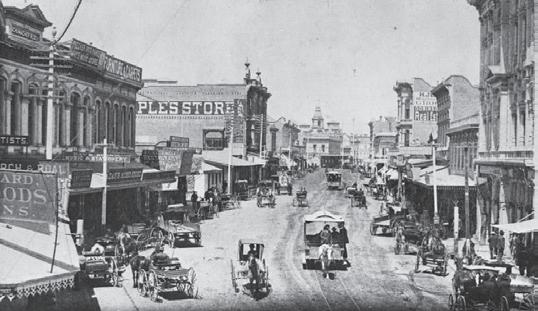 By Suzan Filipek
By Suzan Filipek
A seven-story, 101-unit multi-family apartment building proposed at the site of the Beverly Hot Springs has many devoted spa-goers on edge.
The natural springs — the last one of its kind in the city — will be capped under the development — proposed by Century City-based Manhattan West Real Estate LLC. The project, called Oxford Apartments, is at 308-320 N. Oxford Ave. and 311-321 N. Serrano Ave. on Beverly Boulevard, about one mile east of Larchmont Village.
Warm alkaline waters that bubble up from an artesian well deep underground have refreshed and relaxed area residents and celebrities here for decades. (Madonna reportedly once rented the entire facility.)

Many spa guests were caught off guard about the pending closure to make way for the proposed development, including Teresa Burkett Bourgoise, who became a “reluctant activ-
(Please turn to page 5)
*Sale

578 N. Gower St. 5 Bedrooms 3 Baths Built in 1914 Expansive backyard Slate tile floors in the renovated kitchen $1,920,000 Day — A trusted name in Los Angeles since the 1880s Bob Day’s tradition of service began with his great grandfather’s music store at First & Spring Streets. Bob continues that legacy of service as a top Realtor with Coldwell Banker Hancock Park Coldwell Banker realty • residential & CommerCial 251 n larChmont Blvd ©LC0923 Bob Day 323-821-4820 BobDay@coldwellbanker.com A Trusted Name in Los Angeles since 1882 DRE # 0851770 4 SECTION TWO SEPTEMBER 2023 Larchmont Chronicle Single-family homes SOLD: This home at 233 S. Lucerne Blvd. in Windsor Square sold for $3,025,000 in July. Condominiums 538 N. Alta Vista Blvd. $4,550,000 617 S. Plymouth Blvd. $3,900,000 418 N. Poinsettia Pl. $3,700,000 636 N. Stanley Ave. $3,475,000 100 N. Lucerne Blvd. $3,201,000 587 Wilcox Ave. $3,100,000 233 S. Lucerne Blvd. $3,025,000 940 Hauser Blvd. $2,940,000 232 N. Windsor Blvd. $2,485,000 912 S. Stanley Ave. $2,200,000 624 N. Highland Ave. $2,150,000 162 S. Formosa Ave. $2,000,000 146 S. Arden Blvd. $1,744,000 4415 W. 5th St. $1,635,000 629 S. Sycamore Ave. $1,520,000 555 N. Plymouth Blvd. $1,500,000 7257 Oakwood Ave. $1,422,000 7459 Rosewood Ave. $1,379,342 937 S. Curson Ave. $1,100,000 421 S. Van Ness Ave., #29 $900,000 651 Wilcox Ave., #3C $820,000 109 N. Sycamore Ave., #205 $804,000 929 S. St. Andrews Pl., #303 $758,000 641 Wilcox Ave., #1D $745,000 148 S. Gramercy Pl., #2 $686,000 620 S. Gramercy Pl., #417 $650,000 620 S. Gramercy Pl., #431 $450,000
prices for July.
NATURAL SPRINGS at the Beverly Hot Springs are the only remaining mineral baths in the city.
Hot Springs
(Continued from page 4)
ist” upon hearing the news.

“It’s a remarkable place. It’s been a sanctuary. I’m such an ardent fan.”
Burkett Bourgoise occasionally has a scrub or a massage at the spa, but it’s the soothing waters that have beckoned her to the spa twice weekly for years. These days, she visits more frequently, mostly to get the word out. One positive note is “my skin is looking very good,” she says.
Others, including an architect who has visited the site since it opened 40 years ago, are equally distressed, Burkett Bourgoise told us.
Some nearby residents and passersby are unaware of the
natural springs. “I think the spa was under the radar. People weren’t familiar there was a springs.” Burkett Bourgoise enjoyed her “well-kept secret,” the quiet surroundings and kitsch décor of a faux rock grotto and dark interiors.


But most everyone is against the size of the proposed multi-story development on an already busy corner, she says.
That was the consensus of a recent canvas of area homes by Anna Lindstrom Constable, a former Hancock Park resident and spa afficionado. She carried flyers and gathered signatures for a petition to help save the 100-year-old hot springs.

“The spring has always been very important to the Korean community as well as many Hancock Park residents,”
Lindstrom Constable of Save Beverly Hot Springs told us.
“Of course it is without saying how the traffic in and out of the community will be impacted. We are not opposed to a building that includes the spring, but this building would be over 50 feet taller than allowed.”
It is odd that the developer didn’t include the mineral springs in its proposal, said attorney Jamie Hall of Channel Law Group, LLP. “You would think [the mineral spa] would be a really cool amenity.”
Burkett Bourgoise only heard about the development on July 3 from a woman who has a lifetime membership at the spa. She told Burkett Bourgoise of a City Planning Commission public hearing May 11, which she attended after receiving a notice. (Spa customers claim there weren’t any flyers posted notifying of the meeting.)
Burkett Bourgoise reached out to a land use attorney who learned the spa was slated for demotion unless an appeal was filed in two days, by July 5.




“If nothing is filed, there’s no recourse,” she was told.
Attorney Hall filed the appeal in record time, on July 5, arguing the proposal is “wildly out of scale with the surrounding community and streetscape.”
The appeal further states, “the City has failed to meaningfully analyze the cultural significance of the hot springs
— especially for the Asian American community. Public baths are an integral part of Korean culture and the last remaining hot springs is being eliminated.” While the project was approved by the City Planning Commission at the May
hearing, pending the outcome of the appeal it next heads to a public hearing with the Planning and Land Use Management Committee of the City Council. The appeal is expected to be heard in late August in time for
(Please turn to page 6)
Larchmont Chronicle SEPTEMBER 2023 SECTION TWO 5 Compass is a real estate broker licensed by the State of California and abides by Equal Housing Opportunity laws. License Number 01991628. All material presented herein is intended for informational purposes only and is compiled from sources deemed reliable but has not been verified. Changes in price, condition, sale or withdrawal may be made without notice. No statement is made as to accuracy of any description. All measurements and square footages are approximate. Ali Jack Windsor Square Native & Marlborough Alumna DRE 01952539 213.507.3959 ali.jack@compass.com @thealijack TheAliJack.com DESIGN
Just Listed | 216 N Arden Blvd 1920s English in Prime Windsor Square with Pool & 2 Story Converted Garage 3 Bed | 2 Bath | 1513 sq ft | 7016 sq ft lot | $2,349,000
DRIVEN REAL ESTATE
Hot springs and intangible heritage: a neighborhood institution at risk
In the late 19th and early 20th century when Los Angeles was advertised as a winter haven and retirement town, one of the region’s attractions was its plethora of natural hot springs known for their therapeutic and medicinal properties. Like their European counterparts, Angelenos and tourists “took the waters,” but also followed in the ancient footsteps of Native Americans who held the springs as sacred for their healing powers.
Beverly Hot Springs
Today in Los Angeles, a single one of these hot springs remains — the Beverly Hot Springs spa, now threatened with closure if new development is approved as proposed.
It was not until 1984, when Yang Cha Kim, a doctor of Eastern Medicine, and her husband, Chang Bum Huh, a weightlifter in the 1964 Olympics, bought the old “Wonder Water” bottling plant, that it was transformed into the renowned Beverly Hot
Springs at 308 N. Oxford Ave. For four decades, it has operated as full-service Korean style spa offering steam baths, saunas and hot and cold mineral baths, as well as an herbal pharmacy — its pools still fed by the artesian well that continues to produce over a quarter million gallons of hot mineral water daily. From Native Americans, to Victorian Angelenos, to Korean Americans, the hot spring has linked generations of our city’s history.
Housing versus all else?
The plight of the Beverly Hot Springs highlights, once again, the challenge of preservation of heritage in a dynamic and ever-changing urban environment. As the city grows in density and age, it is constantly confronting its history, having to choose what to preserve and what to replace. For some, the construction of new housing trumps all concerns, especially if the new construction includes affordable
by Brian Curran
housing that our city desperately needs. For others, the loss of access to the natural hot springs and a community amenity such as the Beverly Hot Springs is yet another sign of gentrification and the erasure of cultural heritage. Keep the springs?
I, for one, echo the sentiments of some in the community that it is baffling that any new development would not take advantage of this incredible natural resource. However, the cold hard numbers of the developer’s game seemingly do not encourage putting limitations on its use of square footage nor adding to its risk. Having passed review by the City Plan-
ning Commission as well as having survived an appeal, City Council Office 13 has indicated it will not intervene.

So, go bathe in the waters before it is too late; it is likely that
the hot springs will return once more to their earthen slumber until, in a future generation, they are released once more.
BREAKING NEWS: Apartment project withdrawn. See Page 4.
Perfumery opens and Cookbook opening soon
By Casey Russell
A new store, The Scent Room, opened Aug. 17 at 142 1/2 N. Larchmont Blvd. The space feels light, earthy and grounding, and co-owner Sam Clark says that a lot of thought went into the design. He wanted it to be a cross between a living room and an art gallery, the opposite of, in his words, “the stuffy department store.”
Co-owners Deborah Turner and Clark own another location in Dallas, Texas, but Clark feels this new Larchmont store was meant to be.
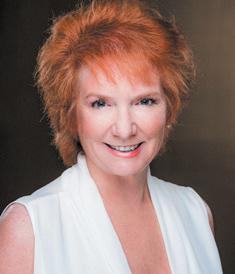
“When I first arrived in Los Angeles, my jeep broke down. I had to push it into the parking
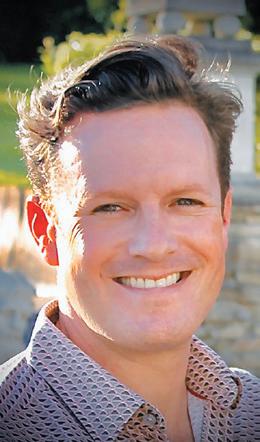

lot of Chipotle,” he said. That’s how he discovered the Boulevard. Smiling, he said, “I feel fate brought me to Larchmont… it has such a personality. I knew we had to do [the store] here.”
Representatives of Cookbook Market told us that they hope to open to the public at the end of September. The new Boulevard market will occupy the space at 310 N. Larchmont Blvd. that previously was the longtime home of Thai restaurant Chan Dara.
Hot Springs
(Continued from page 5)
a Sept. 15 deadline for the City Council to vote on the project.

Density bonus
The developer seeks a density bonus to almost double the allowable 59 units to 101 units by setting aside 15 units for very low income residents. The project would also double the height of the existing 45foot limit to 89 feet.

The project, designed by M3 Architects, includes studio and one- and two-bedroom units and features balconies, glass railings and metal siding and painted metal screens. An elevated pool is on the rooftop deck with a fire pit seating area, according to the 21-page plan submitted to the City Planning Dept.
The new development will include 159 parking spaces above and below ground.
If approved, it would replace an existing triplex, the retail spa and a surface parking lot.
When reaching out to the developers, we were told they do not comment on projects with pending applications.
Historic site
• Formal dining and living room with hardwood floors
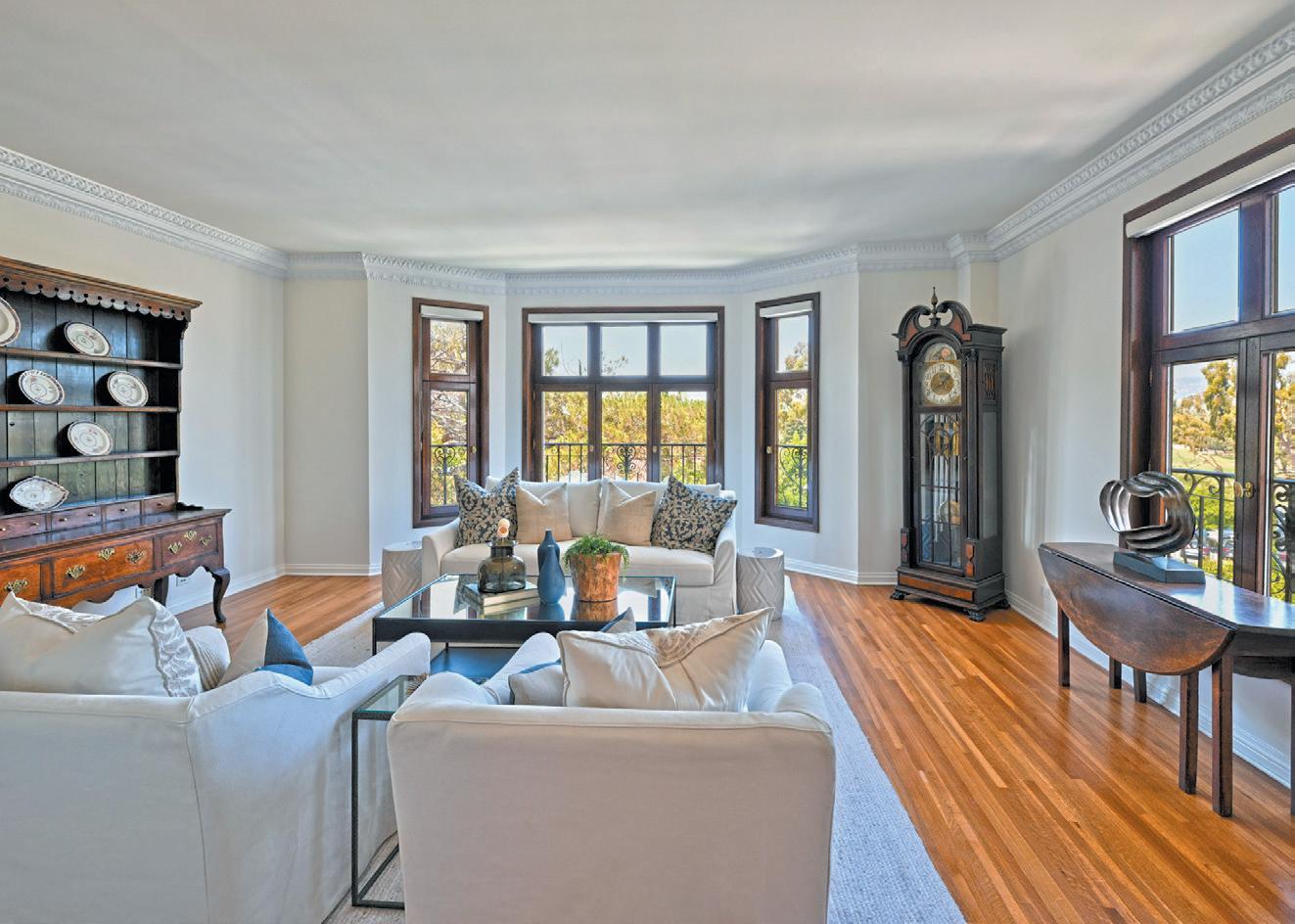
• Large master bedroom with sitting area plus two auxiliary bedrooms
• Two marble clad bathrooms: one full, and one 3/4 bath
• 2 parking spaces: one underground, one street level. Your choice to valet or self park
• Gym and in-ground spa
The Beverly Hot Springs is the only remaining of the many mineral baths that once dotted the city landscape, according to a Dec. 28, 2015, Los Angeles Times article by Patt Morrison included in the appeal.
The hot springs was discovered by oil drillers in the late 19th century, and it supplied water to residents before water mains were installed in this part of the city in 1915.
A May, 14, 1972, Los Angeles Times article by Terence M. Green recounts how the water was bottled and sold until World War II. In a 1972 interview with Grant K. MacCoon, a descendant of the 1910 land purchaser whose family still owned the property in the 1970s, MacCoon said the well then produced about 250,000 gallons of fresh water a day.
316 NORTH ROSSMORE AVENUE, #400
opportunity to live in
Park’s
Country Club Manor.
could be on
• Old world elegance abounds • Impeccably maintained • Bright, airy and delightful with views from all rooms • Double-paned windows GET IT SOLD WITH THE WOODWARDS W WOODWARD REAL ESTATE (323)697-5808 Andrew@TheWoodwardTeam.com DRE #00513357, #01128275, #00811870 Nobody knows it better 6 Generations in Hancock Park EX T R AORDINARY OPPORTUNI T Y TO L IV E IN I NCOM PA R ABLE CO U N T RY CL U B M A NOR Hancock Park’s Finest
Rare
Hancock
premiere full-service condominium building, the renowned
One
the Champs Elysee only with stunning golf course views and magnificent sunsets.
at $1,900,000 6 SECTION TWO SEPTEMBER 2023 Larchmont Chronicle
Offered
On Preservation
A simple, terrific little Japanese restaurant with some big ideas
By Helene Seifer Tucked
into a mini-mall in Koreatown, hibi. by Kabuki is a Japanese restaurant with a fresh California spin. Hibi means “day to day” in Japanese, and owner Sol Lee explains, “We’re always here for you, day to day.” The restaurant started as a ghost kitchen (a take-out or delivery food service cooking in either someone else’s existing brick-and-mortar restaurant or in a rental kitchen), but Lee yearned for a dedicated space and searched for investors.
The Kabuki Restaurant Group, which owns Kabuki, a chain of mid-level Japanese restaurants typically found in malls, was interested in establishing a stand-alone city presence and so, a marriage was forged.

When hibi. by Kabuki opened in April 2023, the menu hewed closely to Kabuki’s penchant for fancy rolls along with the usual sushi and sashimi. Lee added a few innovations and soon learned that those gourmet dishes appealed the most to Koreatown diners and on-trend foodies. Slowly the menu is changing to incorporate more of those options, incorporating fresh produce from local farmers’ markets. Guiding the menu
On the Menu
by Helene Seifer
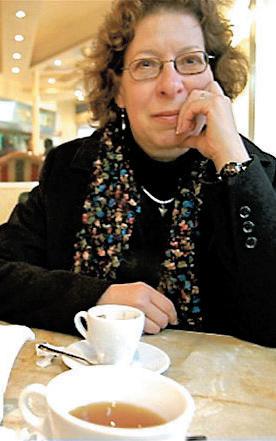
expansion is a Michelin-recognized chef whose name isn’t being released because his own restaurant is being readied for opening.

Owner Sol Lee has a varied and creative background and big ideas about how to incorporate his other interests into the small, serene space in the Olympic Boulevard mini-mall. Although he grew up on Larchmont Wine, Spirits & Cheese
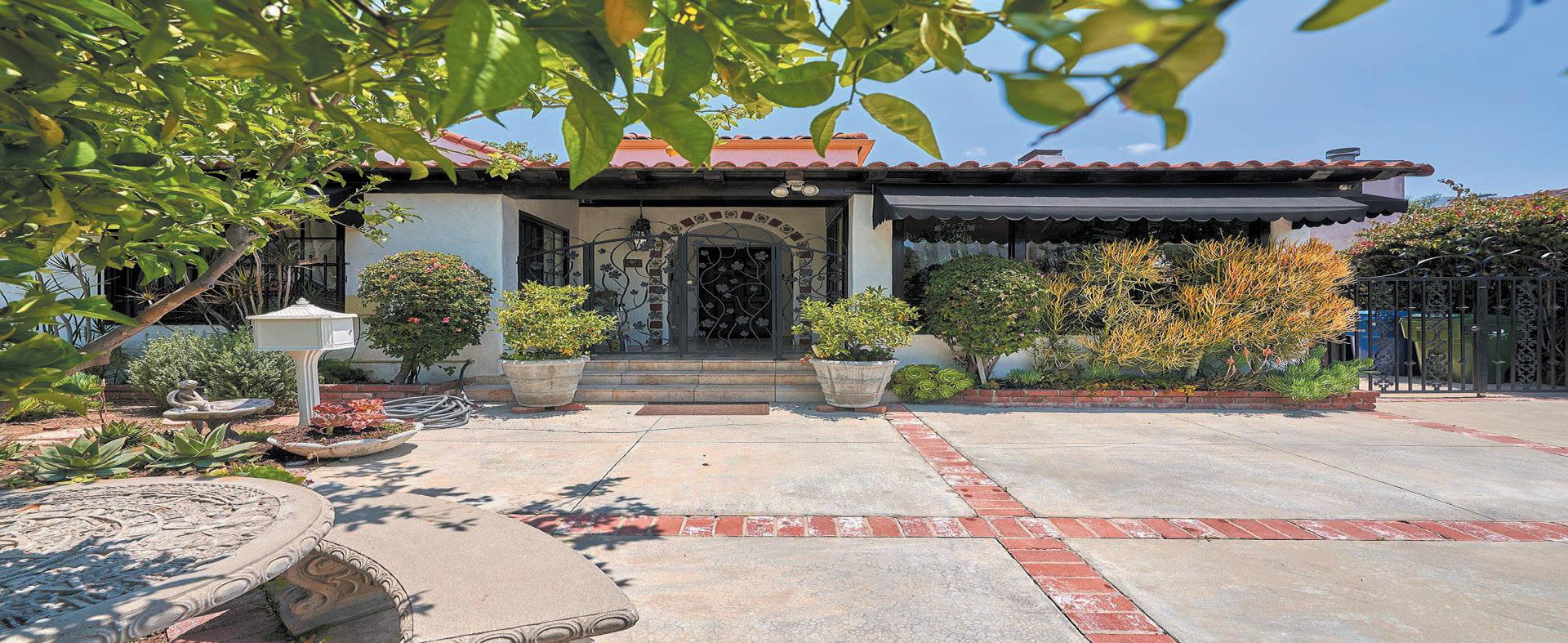
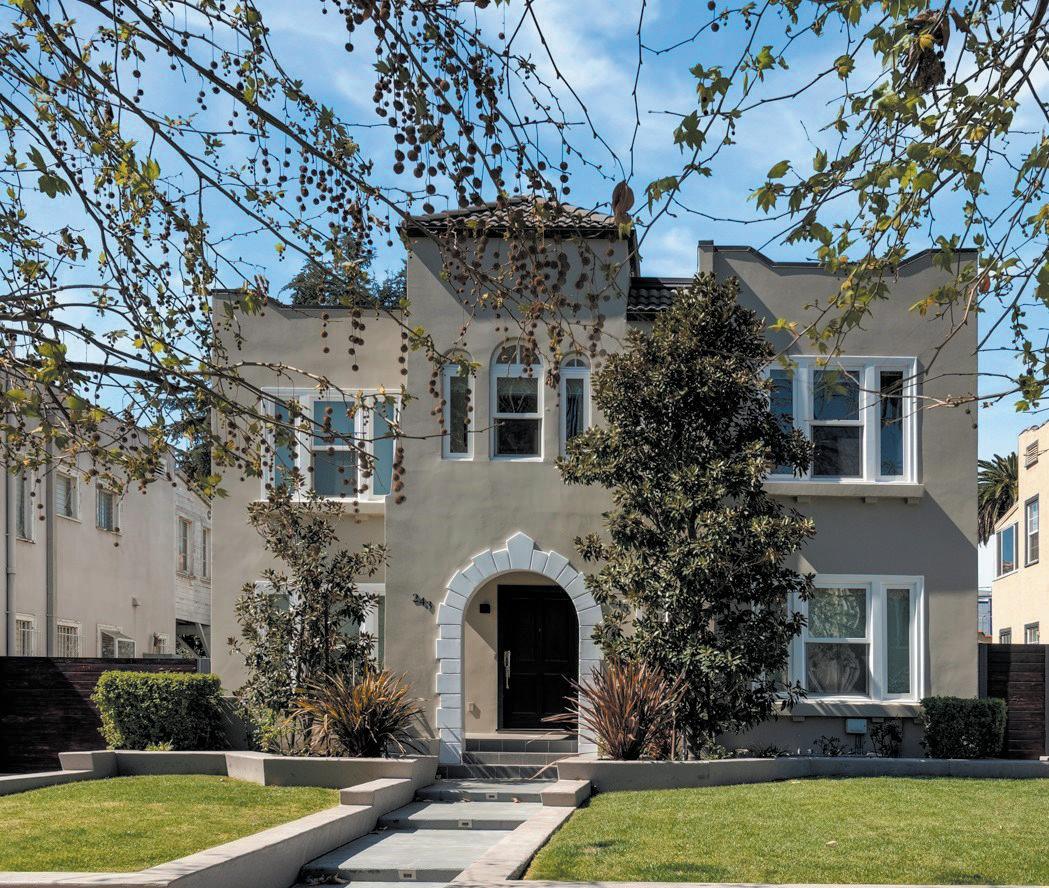

“Number three sandwiches [soppressata salami],” he was a musician in South Korea and spent time in the fashion industry. He wants his restaurant to be an incubator for clothing and merchandising. Music is already a presence, but frankly, was a little too beat-heavy W Hotel lobby for us at the start of our meal. It softened as the evening progressed. Lee also has installed racks for the future unveiling of clothing and “merch.”
As of this writing, food offerings at lunch and dinner are similar, with reasonable

prices ranging from four pieces of salmon sashimi for $15 to the $16 spicy tuna with avocado cut roll wrapped in salmon and the $22 mixed
(Please turn to page 8)


Larchmont Chronicle SEPTEMBER 2023 SECTION TWO 7 June Ahn International President ’s Elite Cell: 323.855.5558 juneahn21@gmail.com www.juneahn.com | CalRE #01188513 Hancock Park 251 N. Larchmont Blvd. Los Angeles, CA 90004 ©2023 Coldwell Banker. All Rights Reserved. Coldwell Banker and the Coldwell Banker logos are trademarks of Coldwell Banker R eal Estate LLC. The Coldwell Banker® System is comprised of company owned offices which are owned by a subsidiary of Anywhere Advisors LLC and franchised offices which are independently owned and operated. The Coldwell Banker System fu lly supports the principles of the Fair Housing Act and the Equal Opportunity Act. CalRE #00616212 Featured Listings for the Month of September by June Ahn 4460 Wilshire Blvd. #703 | SOLD $1,600,000 2 beds plus office/den & 2.5 baths. Appx. 2,760 sq. ft. 245 N. Irving Blvd. | LEASED $5,300 Bright and light 3 bedrooms / 2baths. Approx. over 2,000 sq.ft. 424 N. Arden Blvd. | LEASED $9,000 3 Beds / 2 baths & guest house . Appx. Total square footage is 2,773. Main house is 2,164 s.f. and the guest house is 609 s.f. Dine al fresco and connect with friends Over 15 Larchmont eateries Live raffle Sept 18, 2023 6 – 9 PM and our 12 local food pantries Benefitting HopeNet For tickets: visit hope-net.org or purchase at event Anniversary Alleviating Food Insecurity 35th Celebrating HopeNet’s
On the Menu
(Continued from page 7) sashimi plate. Dinnertime adds the more ambitious $70 tasting menu, which we ordered, resulting in a succession of nine dishes. Our starter was a single bite of octopus. A sliver of cephalopod was grilled and used as a taco-style base, topped with miso butter purée, salmon roe and daikon radish sprouts. Lovely to look at, but the octopus was less succulent than when whole tentacles are gently grilled. However, the next dish was a standout. Tiny crustless katzu chicken sandwiches layered
with a spicy mustardy spread were delicious. The Japanese treatment of breaded chicken results in thin, greaseless, crunchy paillards.
A simple shaved green cabbage in sweet and sour sesame dressing with wonton croutons followed, clearing the way for some fish preparations. Wild hamachi carpaccio and tomatoes marinated in white yuzu (a lemon-like citrus fruit) plus salmon and hamachi nigiri sushi, both perched on a slate slab, were served with spectacular freshchopped wasabi, which has a much brighter flavor than the commonly used wasabi paste. A captivatingly textured
hamachi roll, cut into tiny discs and topped with radish sprouts, fried spring onions and white truffle soy sauce, was a deeply flavorful dish. The last of our sea-centric plates was plump scallops seared in brown butter with corn and flower petals. Simple and terrific.
The parade of savory dishes ended with a bang. A generous mound of purple sweet potato rice formed a base for shishito miso paste, blistered shishitos and succulent strips of 72-hour marinated top blade steak. After so many small, delicate dishes, this one was substantial. We took half home and enjoyed a won-
derful lunch the next day.
Dessert was a refreshing scoop of Korean-style toasted rice-flavored ice cream from Noona’s Ice Cream in New York, a company owned by a friend of Lee’s. The ice cream was dense, creamy and delicious. Liquor options are limited
STUDDED HOT CAKES!

For Our Youngsters, Too!
— Add your favorite — Chocolate Chip, Chocolate Strawberry, S’mores, Banana, Oreo Cookies, Strawberry Banana, Blueberry, Blackberry and Cinnamon Apple, Nutella and Strawberries, Pumpkin (seasonal), Fruity Pebbles, Chocolate Pebbles, Pink Sugared, Reese’s, Strawberry Nutella, Lucky Charms, Summer Berries.
to sake and beer, not unusual for a Japanese eatery. We shared a fruity, flowery $24 300 ml bottle of Born Junsui sake, which complemented the meal perfectly.
hibi. by Kabuki, 3121 W. Olympic Blvd., #103, 213674-7244.

Letter to the Editor


CTG responds to theater columnist

Louis Fantasia is entitled to his theatrical likes and dislikes, but as board members at the Center Theatre Group (CTG) we would like to correct errors and misunderstandings that underlay his mean-spirited August Larchmont Chronicle column “An inconvenient truth at the on-pause Mark Taper Forum.” We are disappointed that rather that join together with theater lovers around Los Angeles to uplift and support the Taper, as it faces an existential crisis, Mr. Fantasia seems more interested in airing a personal gripe about our former artistic director, who retired two years ago.

In June, CTG announced a pause in programming at the Taper in response to financial problems stemming from audience decline post-COVID-19, lapsed subscriptions and the competition of the stay-athome entertainment alternatives, all of which hit as production costs spiraled with inflation. Mr. Fantasia, though, attributes the declining attendance to recent plays from “the last three years” when the Taper offered plays that were “more politically correct than dramatically compelling.”
First, COVID-19 physically closed the Taper for almost two years, from March of 2020 until February of 2022 (so it has only been reopened for 18 months, not three years). Second, the post-COVID-19 eco-



nomic crisis at regional theaters is real at CTG and happening nationwide. Regional American theaters have cut productions, laid off staff and, in some very unhappy cases, closed their doors completely.
The Theatre Communications Group recently estimated that regional theaters mounted 40 percent fewer productions in 2022-23 than in 2019-20. Forty percent! The Public Theater in New York City (home of Free Shakespeare in the Park) recently laid off 19 percent of its staff. The cause nationwide can’t just be Mr. Fantasia’s derided political correctness.
Indeed, the Taper’s recent plays included “Clyde’s” by Pulitzer Prize-winning playwright Lynn Nottage and “King James” by Rajiv Joseph, finalist for the Pulitzer Prize, as well as a 30th anniversary production of “Twilight, Los Angeles 1992,” originally nominated for a Tony Award. These were highly respected and lauded shows. They just sold fewer tickets than they would have in 2019.
Mr. Fantasia also does not seem to understand that the same company programming the Taper also operates the Ahmanson Theatre, which he commends for bringing “significant Broadway plays” to Los Angeles. But despite our best efforts, ticket sales at the Ahmanson are also significantly below comparative 2019 levels, even for a recent show (“Into

(Please turn to page 9)

In the Original Farmers Market • 3rd and Fairfax (323) 933-8446 • Follow Us! @duparsfm
Our Famous Recipe Since 1938 INDOOR & PATIO DINING, TAKE-OUT & DELIVERY Sun. thru Thurs. 6am to 9pm Fri. & Sat. 6am to midnight “Best pancakes in the U.S.” — Esquire Magazine
Our Legendary Buttermilk Hotcakes
©LC0923
8 SECTION TWO SEPTEMBER 2023 Larchmont Chronicle
©LC0122
Over 50 years
Area Rugs to Custom Installations Carpet • Linoleum • Hardwood • Vinyl 323 • 934 • 7282 • lestercarpet@aol.com 7815 Beverly Blvd. • Lestercarpet.com Staff Experts Provide Personal Service Selecting Your Ideal Flooring Announcing the Arrival of a New Shipment of Beautiful Sisal and Seagrass Rolls • Ready for Installation or Custom Rugs • Custom-made area rugs made to fit your lifestyle & space!
Family-Run
Custom
Theater at its best in ‘Peter Pan’ and Arthur Miller productions
There were supposed to be two more plays reviewed in this column than there are, which points to the fragile, if not ephemeral, nature of theater. One, the premiere of Ron Sossi’s “Elephant Shavings” at the Odyssey, was postponed because of COVID-19. The other, Rogue Machine’s premiere of Will Arbery’s “Heroes of the Fourth Turning” at the Matrix, was postponed due to Hurricane Hilary. Both look like interesting new works, but both are scheduled to close before my next column prints.
The theater landscape has been littered with outdoor performances cancelled because of extreme weather. Current increases in COVID-19 strike performers on Broadway and off. Economic uncertainties have more theaters (especially small ones) closing their doors, while those that remain shrink their runs from six weeks to three or four, cancel
Letter
(Continued from page 8) the Woods”) that, as Mr. Fantasia confirms, “featured perhaps the best cast in a musical I have seen in Los Angeles.”
Ironically, Mr. Fantasia views today’s Taper unfavorably compared to the Taper of founding director Gordon Davidson, who is deservedly honored for fostering outstanding productions like “Angels in America” and “Zoot Suit.” But those shows were controversial and politically daring in their time. In Davidson’s first production, John Whiting’s “The Devils,” about a renegade priest and Catholic repression, half the audience walked out on opening night, offended by what Mr. Fantasia might see as that era’s woke times. The Taper has always taken risks … now those risks are just far more expensive, and fewer folks are willing to leave their homes to come experience the show.
Finally, though he did not mention him, we hope Mr. Fantasia welcomes our new artistic director, Snehal Desai, who began work this summer and is now busily planning new programming at our two operating venues, the Ahmanson Theatre downtown and the Kirk Douglas Theatre in Culver City, as well as a slate of non-traditional offerings in the Taper such as cabaret nights and readings of new plays. We invite all of Los Angeles, including Mr. Fantasia, to watch out for our exciting new season. If you want to save live theater, buy a ticket and go see a show. Let’s look forward, not back.
Diana Buckhantz
Sarah Clossey
Amy Forbes
Jamie Patricof
Board Members, CTG
Tuesday or midweek matinee performances to save costs, and replace elaborate sets with bare-bones designs or projections. One could gnash one’s teeth and bemoan the state of the art, but… Two recent productions, one large and one small, give reason for hope.

The first is the hilarious Peter Pan Goes Wrong at the Ahmanson until Sept. 17, 213628-2772, centertheatregroup. org. This is J.M. Barrie by way of Monty Python; Mary Martin (the TV Peter Pan of my youth) mashed up with Carol Burnett. The premise, flimsy as it is, is that a British university drama club is putting on the play and that everything that can go wrong will. This is the team that, starting from their own college drama days at England’s LAMDA — the London Academy of Music & Dramatic Art — put together such previous larks as “The Play That
Theater Review by
Louis Fantasia
Went Wrong.” While they have now built a worldwide empire, their sense of fun — of play — is deeply rooted in the magic innocence of children’s theater and the absurdity of English Christmas pantomime.
The fact that the production has a Broadway-level revolving set and flying rigs does not take away from its fundamental simplicity: Capt. Hook holds the audience in the palm of his one good hand for nearly five minutes as he tries to open a bottle of poison with his piratical prosthesis; Tinkerbell, a fairy too comedically hefty for flight, has the entire audience
clapping and believing, not only in her, but in the magic of theater. This is theater at its best, creating a shared community for the night among actors and audience.
The production of Arthur Miller’s A View from the Bridge at the Ruskin Theatre in Santa Monica (through Oct. 8, 310397-3244, ruskingrouptheatre. com) does much the same on a searingly deeper level. Miller’s story, set in the Italian-American world of Brooklyn dockyards of the 1950s, tells of illegal immigrants who come to America for work, the emotions that entangle them and the passions that betray them.
Director Mike Reilly could have, I suppose, “updated” Miller’s melodramatic tale by setting it in, say, El Paso today, or “deconstructed” it along the lines of Ivan van Hove’s recent bare-bones London production. Instead, Reilly takes the radical notion of simply trust-
ing the playwright and staging what Miller wrote: a passionate, operatic story of dreams dashed and love gone wrong.
The production features a first-rate cast led by Ray Abruzzo’s Eddie Carbone, Kim Chase as his long-suffering wife, Aurora Leonard as the young niece at the center of the tragedy, and Sal Viscuso as the lawyer who guides us and tries to make sense of it all. The rest of the cast members inhabit their roles with equal commitment and panache. The tragic events unfold with train-wreck inevitability, and we are reminded why some American playwrights are greater than others.
Catharsis comes in two forms in the theater — the release of emotion through laughter or tears. Aristotle knew that that release was good for us 2,500 years ago. He would have been very happy with either production today.
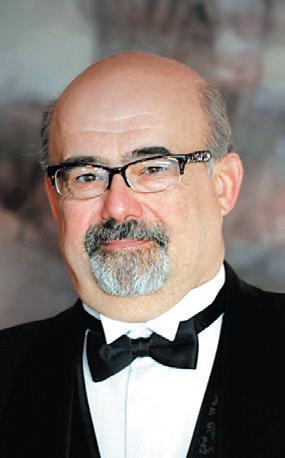
Larchmont Chronicle SEPTEMBER 2023 SECTION TWO 9
Monsieur Marcel turns 30? Mais oui!
 By Helene Seifer
By Helene Seifer

The Original Farmers Market has always been a great resource for our community, with multiple food stalls, fresh produce and arguably more varieties of hot sauce than anywhere else on the planet. But if one wants a stick of salted French butter, a selection of fine cheeses, a platter of fresh-shucked oysters, a perfectly plated coq au vin or a whole rock fish to grill at home, Monsieur Marcel’s mini-empire, which celebrates its 30th anniversary Sept. 30, has your
back with a gourmet market, French bistro, seafood market and Roxy & Jo’s Seafood Grill & Oyster Bar. How this French multipronged business came to settle in at the Original Farmers Market involves a complicated journey. Monsieur Marcel owners Katy and Stephane Strouk met in a cafe in Paris when Katy, an American student, was backpacking through Europe the summer after her junior year in college. Stephane, a native of France, raised in both the south of France and Par-

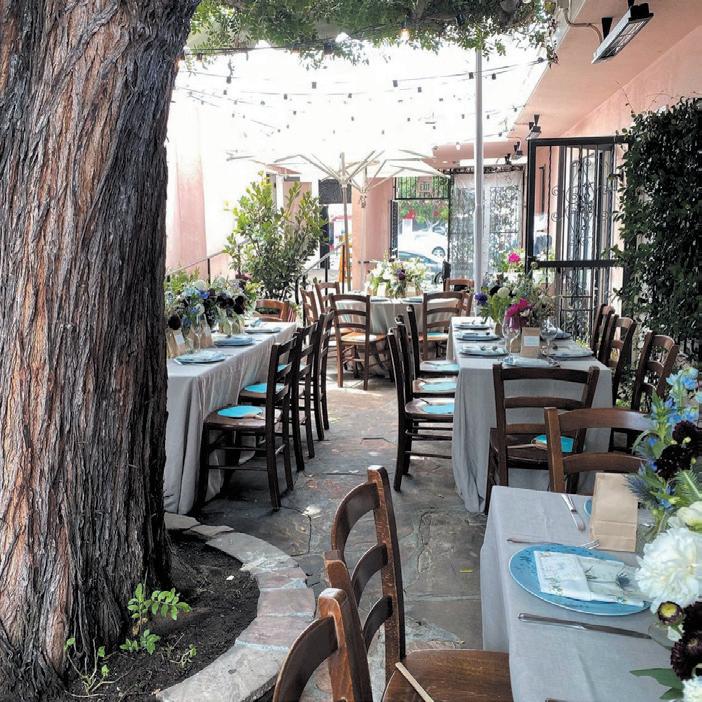


is, had quit his corporate job and planned to travel until his savings ran out, starting in Los Angeles. Katy, who lived in Orange County with her parents, told him to call when he arrived in the U.S. When he did, she invited him and his five travel companions to come crash with her family. Instead of traveling the world, he stayed for months. Instead of finishing college, she moved to Paris with him, where Katy got a job at Ford Models Paris and Stephane worked for his family’s contemporary art gallery. They visited Southern California periodically, most notably for their wedding. During one visit in 1989, the Strouks met a friend for coffee at the Original Farmers Market. The city had always seemed impersonal to Stephane Strouk, but the farmers market reminded him of “a little town in a big town.”
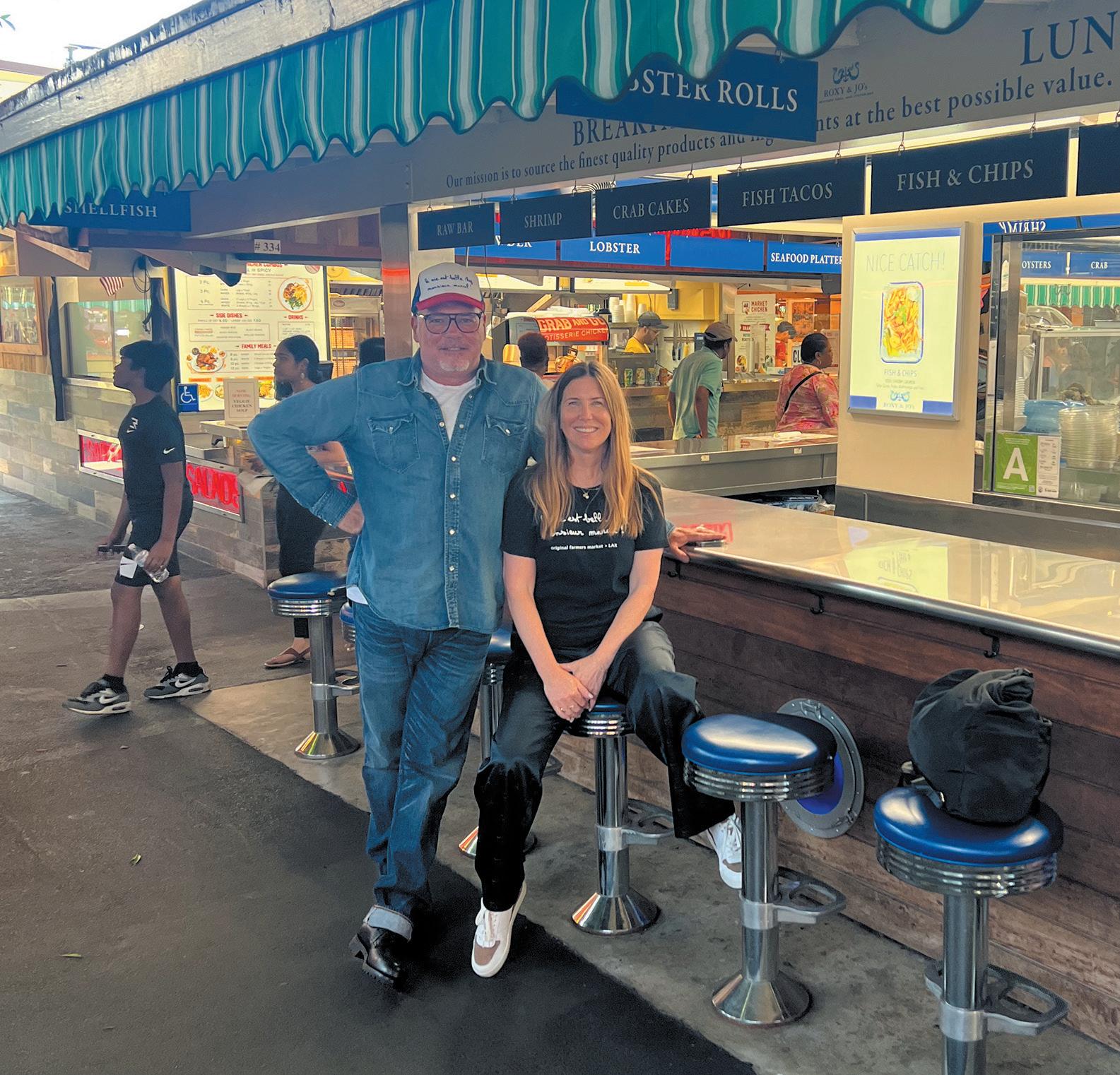
The Strouks started to feel constrained by the lack of opportunities in France and, in 1993, moved back to Los Angeles to pursue the American Dream. Stephane remembered how much the Farmers Market had reminded him of his Paris neighborhood, where people knew each other and talked to one another. They felt at home and decided to put down roots at the corner of Third and Fairfax. They opened a crêperie in 1993, followed by the Mr. Marcel cheese counter in 1994, named ironically for Stephane’s dad, who
absolutely hated cheese. They have overseen many changes in their 30 years of doing business in the market. They no longer run the crêperie (although, several owners later, it still exists) and in, 1995, they took over a failed grocery store, incorporating the cheese counter into the Monsieur Marcel Gourmet Market. In 2001-2002, the market was renovated, and the French Bistro opened, the only sit-down, white tablecloth, full-service restaurant within the main Farmers Market area. The gourmet market stocks more than 6,000 products imported from around the world. The Strouks take three buying trips a year, attending fancy food shows and, as Katy Strouk explains, “We work with a lot of artisans who don’t produce enough for big stores.” For example, they stock a rich chocolate bar they discovered in Tahiti and, “We hand carry back strawberry jam made by two women in France’s Normandy region.”
In a nod to Stephane





Strouk’s time eating fresh fish in the South of France, when Tusquellas Sea Foods’ owner Bob Tusquellas was ready to retire, Monsieur Marcel Seafood Market was born. Fresh-caught fish and seafood is delivered there daily, as well as to the Strouks’ newest enterprise, Roxy & Jo’s Seafood Grill & Oyster Bar, opened in 2020. Named for their daughters Roxanne, 22, and Josephine, 14, customers sit at the counter to enjoy such fare as fish and chips, lobster rolls and oysters. According to Katy Strouk, they shuck more than 2,000 oysters a week. With four successful businesses within arms length of each other at the Original Farmers Market, and even a Monsieur Marcel counter in the Original Farmers Market section in Terminal 5 at Los Angeles International Airport, do Katy and Stephane Strouk plan to celebrate their 30-year anniversary with any new enterprises? “We have no plans,” assures Katy, “But we’re always open. Stephane loves to open businesses.”

©LC0923 7313-7321 Beverly Blvd | 323.297.0070 www.angelinirestaurantgroup.com 7313 – 7317 Beverly Blvd., Los Angeles, 90036 | 323.297.0070 www.angelinirestaurantgroup.com Open for Breakfast – Lunch – Dinner – Catering Mention this ad for a special treat! We are available to cater your holiday parties, weddings, showers and all types of events. We also have private dining rooms and areas for private events. Ask about our private dining spaces & catering options! Call us at 323.297.0070 ext 27 or e-mail catering@angeliniosteria.com BOGIE’S LIQUOR 5753 Melrose Ave. Call 323-469-1414 ©LC1122 Open 7 Days Hours: Open 10 a.m. Close 2 a.m. ©LC 0821 Restaurant Hours: Mon.- urs. noon to midnight Fri.-Sat.-Sun. noon to 1:00 a.m. Bar open till 1:00 a.m. Mon.- urs. ~ 1:30 a.m. Fri. & Sat. 3357 Wilshire Blvd. • 213-385-7275 • thehmsbounty.com RESTAURANT & COCKTAILS Lunch & Dinner Every Day of the Year ©LC0921 Vine American Party Store 5969 Melrose Ave. (at Wilcox) 323-467-7124 • www.vineamericanparty.com Come to Party Headquarters! Everything Needed from Simple to Elegant Affairs Through September — 20% Off (except printing, discounted goods, balloons and balloon delivery) • INVITATIONS • DECORATIONS & BALLOONS • TABLE COVERS & SKIRTS • NAPKINS, PLATES, CUPS • GOODY BAGS • BUBBLE MACHINES & MUCH MORE! 10 SECTION TWO SEPTEMBER 2023 Larchmont Chronicle
STEPHANE AND KATY STROUK at Roxy & Jo’s Seafood Grill & Oyster Bar.
Mirren shines as ‘Golda,’ racing gamer, Icelandic thriller
Golda (9/10): 93 minutes without credits. PG-13. The always brilliant Helen Mirren (in Oscar-quality makeup that took 3½ hours per day to apply) shines in this traumatic portrayal of heroic Golda Meir, Israel’s Prime Minister through the harrowing Yom Kippur war in 1973. But she must share the limelight with director of photography Jasper Wolf because his cinematography captures her claustrophobic situation battling the war and dealing with her generals and cabinet, Henry Kissinger (Liev Schreiber) and the U.S. and serious cancer treatments (even though she still smokes incessantly) all cascading down on her at once, with many dark, tight shots and constricted locations, endarkening the ambiance to match her problems.
Gran Turismo (9/10): 135 minutes. PG-13. I’ve seen most of the sports movies made, and this is right up there with the best of them like “Hoosiers” (1986) and “Miracle” (2004). It tells the true story of a former race car driver (David Harbour) and a motorsport executive (Orlando Bloom) who took a gamer (Archie Madekwe) who had never driven a real car and gave him a chance to be a real Grand Prix race car driver. It
is enhanced by Oscar-quality sound and cinematography that capture the speed and danger of racing better than anything I’ve seen, including the televised races themselves.
Operation Napoleon (9/10): 115 minutes. NR. Based on the best-selling novel of the same name by Arnaldur Indriðason and inspired by Winston Churchill’s “Operation Unthinkable.” Kristen (Vivian Didriksen Ólafsdóttir), an ambitious Icelandic lawyer, receives a text from her brother who is exploring on the Vatnajökull ice cap (the most voluminous in Iceland) that he and his friends have discovered a WWII Nazi plane. He sends her pictures and is then silent. Shortly thereafter, she receives another text from him saying he is in trouble. She thinks he’s joking but quickly discovers that he is serious, and she loses complete communication with him.
Directed by Óskar Thór Axelsson, what follows is a captivating thriller with nonstop tension as she hooks up with her friend, Steve Rush (Jack Fox), to try to find her brother, all the while pursued by nefarious CIA Director Willam Carr (Iain Glen) and his powerful forces.
The locations are cold and
At the Movies with Tony Medley
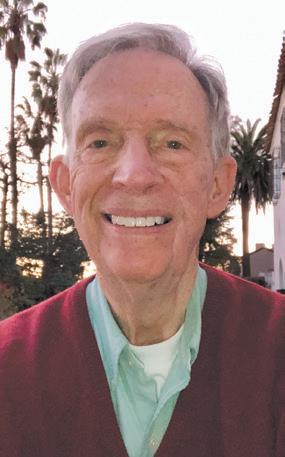

beautiful, the cinematography (Årni Filippuson) exceptional, and the conducive music (Frank Hall) adds to the tension. With a screenplay by Marteinn Thórisson, and highlighted by fine acting, this is as good a thriller as anyone could want. In Icelandic and English.
Retribution (9/10): 90 minutes. R. This is Liam Neeson’s best thriller since the exceptional “Taken” in 2008. From a brilliant soft start where you suspect you are being set up for danger, he and his two children find themselves trapped by an unknown madman in his inventive and devious scheme. Neeson gives a bravura performance as the tension mounts and his untenable position gets worse and worse. While the car chases border on ludicrous, they are necessary. They usually don’t hand out Oscars for thrillers, but Neeson deserves a nomination, at least.
Madeleine Collins (8/10):
113 minutes. NR. There have been movies before about people living double sexual lives with lovers in different cities, but they are always men. In this one, though, it’s a woman, Margot / Judith (Virginie Efira in a sparkling performance), doing the splitting. In Switzerland, she is Margot and lives with Abdel (Quim Gutierrez) and the little girl they are raising. In France, she is Judith and lives with famous orchestra conductor Melvil (Bruno Salomone) and their two older boys. Brilliantly directed by Antoine Barraud, this is an absorbing tale of lies and deception that tracks her complex life as it slowly, inevitably, falls off the rails. In French.
Between Two Worlds (8/10): 106 minutes: This is another scintillatingly directed story by Emanuelle Carrère based on French journalist Florence Aubenas’s best-selling nonfiction investigative work “Le Quai de Ouistreham,” looking at precarity in French society through her experiences in the port city of Caen. The always special Juliette Binoche goes undercover to report on the lives of women who clean the cross-channel ferry. As she connects with her fellow cleaning women, she becomes aware of the value of the rela-
tionships she is making and struggles to justify her deceit with her friendships. Except for Binoche, all the women playing cleaners in the film are actual cleaners, not actresses, which adds authenticity. In French.
Untold: Hall of Shame (8/10): 78 Minutes. TV-14. Netflix. Athletes using anabolic steroids seriously damaged the integrity of sports, especially baseball and its records. This documentary examines this disgrace with interviews with Victor Conte, the head of the Bay Area Laboratory Co-operative (BALCO), the people who investigated him, like Jeff Novitzky of the FDA, and some of the athletes who participated, like sprinter Tim Montgomery, who honestly says, “When you’re doing a crime, you think you are the smartest person who is committing the crime. Then when you look back you say, ‘That was the dumbest thing I ever thought of.’” Conte rationalizes what he did, “If you’ve got the knowledge that that’s what everybody’s doing and those are the real rules of the game, then you’re not cheating.” To its credit, it lays out the case against Barry Bonds, confirming the validity of his absence from the Hall of Fame.
Larchmont Chronicle SEPTEMBER 2023 SECTION TWO 11
Reinforced concrete: the modern equivalent of stone in art?

n
New exhibit at LACMA
By John Welborne
A new exhibition just opened at the Los Angeles County Museum of Art (LACMA). “Eternal Medium: Seeing the World in Stone” includes 125 works from circa 2200–1800 B.C. to recent pieces by contemporary artists. The exhibit curator’s focus is on the role that imagination plays in perceiving images in the natural markings of stone.
Soon to be on view locally is how Pritzker Prize-winning architect Peter Zumthor, Hon. FAIA from Switzer-
land, imagines the natural and form-made markings of the modern medium of reinforced concrete. Visitors will be able to examine the product of his imagination when scaffolding, falsework and formwork — now encasing LACMA’s under-construction

David Geffen Galleries building — are removed. The new building is expected to open near the end of 2024.
$750 million goal surpassed

On Aug. 23, the art museum announced that its “Building LACMA” campaign had reached and ex -

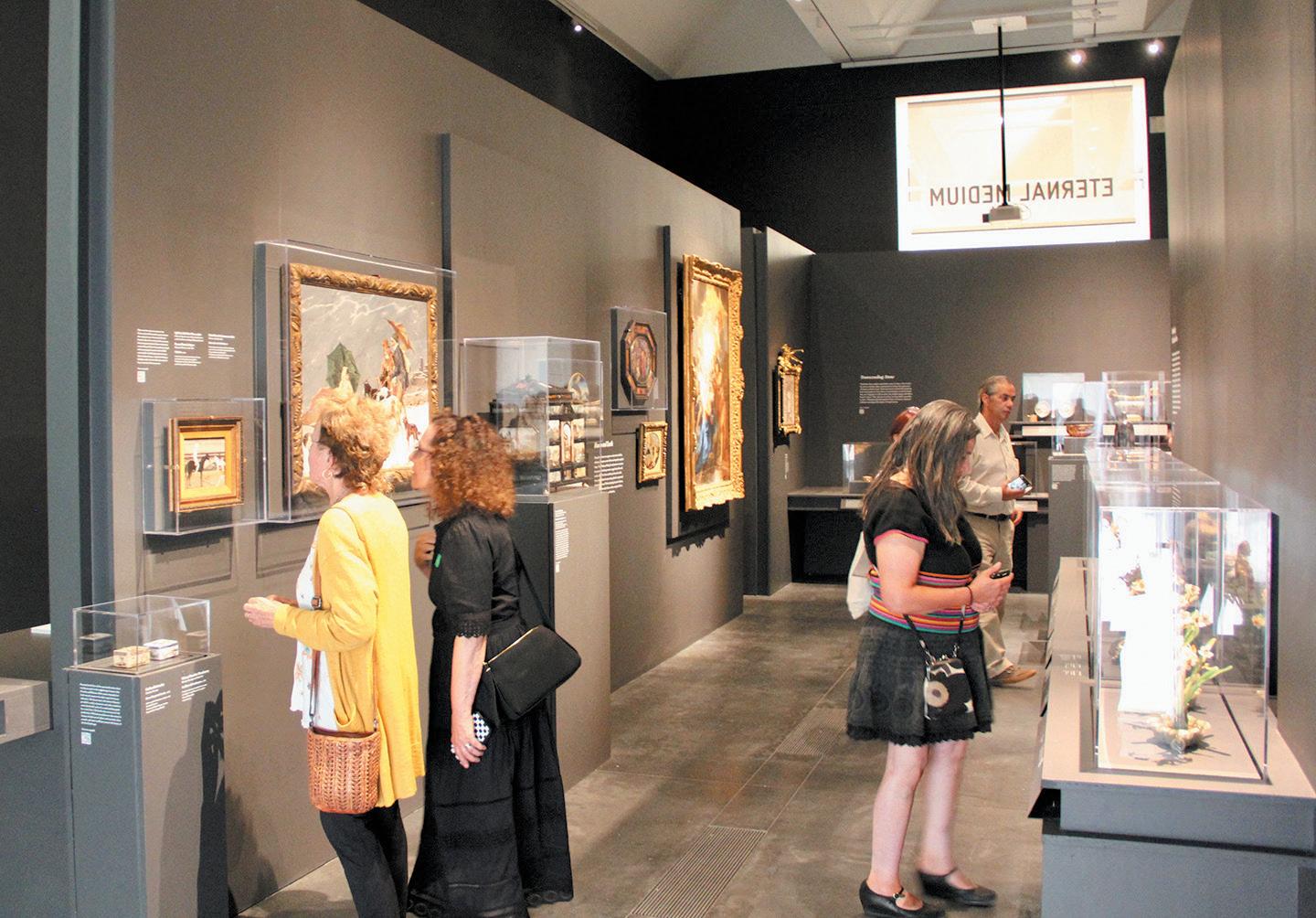
Sun’s Out.... Now’s the Time to Repair Your Gutters and Downspouts! Local Hancock Park resident for over 35 years, specializes in gutter cleaning and repair. Brian Brady (213) 910-0980 © LC 0717 Handyman Services, too! Z ZAVALAELECTRIC Call 818.500.7778 For immediate installation • Complete Electrical • Service and Repair • Residential • Commercial • Bonded Insured Serving All Larchmont Hancock Park & Wilshire Communities Guaranteed Excellence State Lic. #C-10 556059 LC0509 606 N. Larchmont Blvd., L.A. 90004 5312 Valley Blvd., L.A. 90032 lipsonplumbing@gmail.com INSURED LIC.# 481793 323-469-2395 “Your Neighborhood Plumbers” LIPSON Plumbing, Inc. Celebrating 46 Years on Larchmont ©LC0122 12 SECTION TWO SEPTEMBER 2023 Larchmont Chronicle
GALLERY VISITORS examine stone pictures and carvings.
WESTERN PORTION of the new David Geffen Galleries building under construction in August 2023. Park La Brea and its apartment towers are to the north.
CLOSE-UP VIEW shows roof at the west end, nearly ready for pouring and completion, in August 2023.
(Please turn to page 13)
COMPLETED GALLERIES and their ceilings are beneath the in-process reinforcing bar (rebar) installation that will form the interstitial space separating the gallery ceilings from the building‘s roof. On a single level, there will be 26 “core galleries” — concrete rooms where art generally can be displayed on eight walls (four interior; four exterior) of each room.
ceeded its fundraising goal of $750 million.



Visible from above
It now appears that nearly one half of the 26 planned gallery rooms in the new building have had their walls and ceilings completed, constructed just like the remainder of the massive new building — in reinforced concrete. The museum’s Aug. 23 announcement indicated that the entire project is now more than 65 percent complete.



Materiality of stone

The new exhibition about stone, as described by LACMA, “brings together a wide range of mostly historical European stone carvings and pictures, juxtaposing them with the similar works in other medi-
ums for context and comparison. Organized into nine interrelated displays, the show encourages visitors to appreciate the works’ optical effects and to look more closely at how they are constructed.”
The art on exhibit comes primarily from three collections: LACMA’s own, the Rosalinde and Arthur Gilbert Collection at London’s Victoria and Albert Museum and the V&A’s collection, plus art from public and private collections in California.
The exhibition is in the Resnick Pavilion at LACMA, 5905 Wilshire Blvd., and it continues through Feb. 11, 2024. Learn more about this and other fall openings, plus the Geffen Galleries construction, at lacma.org.
Larchmont Chronicle SEPTEMBER 2023 SECTION TWO 13 323-469-2981 • supremeroofing.net 1015 N. Gower St., 90038 © LC0922 Lic.#386172 Residential & Commercial Your local roofer at the same location for over 97 years. Customer satisfaction will bring you back to our FULL SERVICE Company
make a difference.
“Experience does
DRAPED MARBLE (Carrara, St. Laurant, Brown Onyx) by Analia Saban, 2016.
RECTANGULAR GALLERY WALLS are visible to the right of completed galleries whose ceilings will be poured using the tan plywood shown.
BRIDGE FLOOR over Wilshire Boulevard connects to the location of the new building’s galleries that will be above the ceiling of a 300-seat theater on the ground level on the south side.
(Continued from page 12)
Bridge Theater
325 N. Larchmont Boulevard, #158 Los Angeles, California 90004 windsorsquare.org
157 N. Larchmont Boulevard
Party House Problems
There is a positive update about the problem-causing party house at 300 North Plymouth Boulevard — the northeast corner of Plymouth and Beverly. Council District 13 Councilman Hugo Soto-Martinez spoke with City Attorney Heidi Feldstein Soto and shared with her the incredibly detailed and exhaustive documentation prepared by Sam Uretsky, Delilah Loud and others on behalf of the North Plymouth Coalition (NPC) and the Larchmont Village Neighborhood. The City Attorney has agreed to assign a prosecutor to the case!
Prosecution
The City Attorney seems to be taking this case quite seriously, especially in light of her decision to prosecute the Nightfall Group that operates similar party houses in Hollywood. City Attorney Feldstein Soto (no relation to the councilman) has indicated that her office is addressing the situation as a systemic issue with which the city needs to deal, and she says her office is looking to hold not just the promoters and property owners responsible but also the media outlets that share the invitations. All good news for the neighbors.
Permanent solutions sought

Working in conjunction with the City Attorney, Councilman Soto-Martinez reported that his office also is looking for more permanent solutions. The WSA is encouraged that the council office is now leading on this issue.

The offices of State Senator Maria Elena Durazo and Assemblymember Rick Chavez Zbur also have been notified about the problem, and they, too, are offering support.
Thanks due
The community’s thanks are due to Councilman Soto Martinez and his CD13 staff members, Alejandra Marroquin and Karla Martinez, as well as to many others who have stayed the course on this problem to produce the tangible results. An especially big shout-out must go to Sam Uretsky, Delilah Loud and the NPC for leading the charge!

The Windsor Square Association, an all-volunteer group of residents from 1100 households between Beverly and Wilshire and Van Ness and Arden, works to preserve and enhance our beautiful neighborhood. Join with us! Drop us a line at 325 N. Larchmont Blvd., #158, Los Angeles, CA 90004, or visit our website at windsorsquare.org.
POLICE BEAT
Burglaries on rise; take precautions
OLYMPIC
DIVISION
Senior Lead Officer Joe Pelayo reports the area continues to have burglaries from motor vehicles, especially near Beverly Boulevard and Van Ness Avenue.

WILSHIRE DIVISION
The current crime report was not available at press time.
OLYMPIC DIVISION
Furnished by Senior Lead Officer
Joseph Pelayo
213-793-0709
31762@lapd.online
Twitter: @lapdolympic
WILSHIRE DIVISION
Furnished by Senior Lead Officer
Dave Cordova
213-793-0650
31646@lapd.online

Twitter: @lapdwilshire
Plymouth Boulevard assailant awaits mental evaluation
By Nona Sue Friedman
A homeless man who was arrested for attacking a 72-year-old woman in December 2022 near Eighth Street and Plymouth Boulevard is still in custody awaiting a
License #768437
mental evaluation. The mental health courts will determine his competency to stand trial.
The Larchmont Chronicle reached out to a spokesperson from the public defender’s office to get a comment from
the assailant, but the assailant refused to comment.
The victim, who was attacked twice in the same morning, was punched in the face and stomach multiple times before she was able to escape.
©0822 1551 E. 25th St., LA 90011 SERVING THE LARCHMONT AREA FOR OVER 60 YEARS! SERVING THE LARCHMONT AREA FOR OVER 60 YEARS! Lynn Shirley (323) 463-9201 FAX (323) 463-1259 Since1959 • COMMERCIAL • RESIDENTIAL
PLOTKE Plumbing Inc. 14 SECTION TWO SEPTEMBER 2023 Larchmont Chronicle
©LC0923
‘The Unicorn Rests in a Garden’ hangs at The Met Cloisters in
Earlier this month, during a visit to New York City, I had the pleasure of visiting The Met Cloisters, a branch of The Metropolitan Museum of Art dedicated to the art and architecture of medieval Europe. Situated on four acres overlooking the Hudson River, the museum was originally conceived by American sculptor George Grey Barnard. The artist lived and worked in rural France before World War I and collected most of the medieval sculpture and architectural fragments on view at The Cloisters today.
The word “cloister” describes a covered walk in a convent or monastery bordered by a colonnade that surrounds a central open courtyard. Deriving their name from the Latin claudere meaning “to close or shut,” the cloisters at the museum’s property number four. Each is festooned with lush, elaborate plantings and is named for the location in France from which it came. Starting at the museum’s 15th-century Trie Cloister (named for Trie-surBaïse in the Pyrenees region), I made my way into the Treasury, where I was met with a dimly lit room replete with glass vitrines holding glittering reliquaries and precious works of jewelry and tableware. It’s in this gallery that I came across a close etymological relative of “cloister” — a set of 13th-century embellished plaques from Germany made using the cloisonné technique. In this art form that dates back to ancient Mesopotamia and Egypt, a decoration is created by affixing gold or silver wire to the face of a metal object to form compartments (called cloisons in French). These partitioned areas are then filled with enamel, gemstones or other richly colored materials to form patterned or pictorial schemes.
Moving further into the gallery, I spotted a display case holding another enameled plaque, this one from Limoges, France, from the 12th century. In the rectangular frame, two mournful winged angels beholding the Crucifixion wave censers that perfume the air and sanctify the event. Resplendent with jewellike color, the angels are illustrated in front of a shining gold background ornamented with swirling flourishes in a style termed vermiculé. The moniker comes from the Latin vermiculus, meaning “little worm,” which also provides the origin for “vermicelli,” a thin pasta popular in both Italian and Vietnamese cuisines. The answer to what makes vermicelli pasta (defined in Italy as having a thickness between 2.08 and 2.30mm) more wormy than other long pastas is anyone’s guess, but the inquiry did have me searching the internet for
“diameter of a worm.”


Exiting the Treasury, I walked up a stone staircase to the museum’s upper level, landing in the Boppard Room. Named after the Carmelite church of Saint Severinus in Boppard, Germany, this gallery is known for its 15th-century stained glass from said church, but it is a carved oak choir stall from France in which I was most interested. The two side-by-side stalls are outfitted with tiny hinged seats that I imagine could only support the smallest of bums. Called misericords from the Latin misericordia, meaning “mercy,” these supports offered a modicum of comfort to clerics and monks who needed a respite after long periods of standing.
Misericordia lends itself to the title of another emblem of clemency present during the Middle Ages. The “misericorde” was a long, narrow knife used to deliver the merciful stroke of death to a knight who had been gravely wounded. Designed with a blade thin enough to strike through a gap in one’s
Word Café
by Mara Fisher


armor, the weapon, along with the hard wooden mini-seat, demonstrates that compassion comes in many forms.


Images of sharp objects abound in the neighboring Unicorn Tapestries Room, which presents exquisitely woven depictions of noblemen hunting an elusive unicorn amid a verdant landscape. Among the most renowned objects in The Met Cloisters’ permanent collection, these late-15th-century tapestries illustrate the bloody clash between the unicorn’s horn and the hunters’ spears, while a smaller, more subtle
“sword” looks on.
In the foreground of the tapestry titled “The Unicorn Rests in a Garden,” the spindly stalks of wild irises extend upward from a millefleur meadow encircling the wounded unicorn. The scientific name for the flower is the Latin Gladiolus, meaning “small sword,” named for the sharp, blade-like leaves from which its vivid purple-blue
blooms protrude. The word is a diminutive of gladius, which simply means “sword,” and the flower shares this antecedent with the famed Roman swordsmen known as gladiators. I descended the trail that leads from The Cloisters through Fort Tryon Park and eventually back to the subway, while visions of unicorns danced in my head.
B Gaddy ElEctric since 1978. Residential • Comme RC ial Call Bill 323-462-1023 Local References Service & Repairs Licensed & Insured LIC #700914 • Upgrades • Landscape • Pool Lights • Phone & Computer Lines • Security & Emergency Lighting ©LC1010 ALAKAZAM COMMERCIAL & RESIDENTIAL • Every Style: Sofas, Chairs, Slipcovers • Replace Weather-proof Lining • Broad Selection of Fabrics • Draperies & Roman Shades Call Rosie for FREE Estimates 310-491-8409 UPHOLSTERY & DRAPERY HIGHEST QUALITY WORKSMANSHIP Affordable Prices ©LC0720 ADT Security Services Let us be your 1st Responder. • Response • Patrol • Alarm • Monitoring Four decades serving Mid-Wilshire Los Angeles ©LC1218 Please call now for a special offer for new customers who sign up for patrol or response services. For more details, contact Mike Ball 818-435-3179 Lic. # PPO 120288
NYC
Larchmont Chronicle SEPTEMBER 2023 SECTION TWO 15

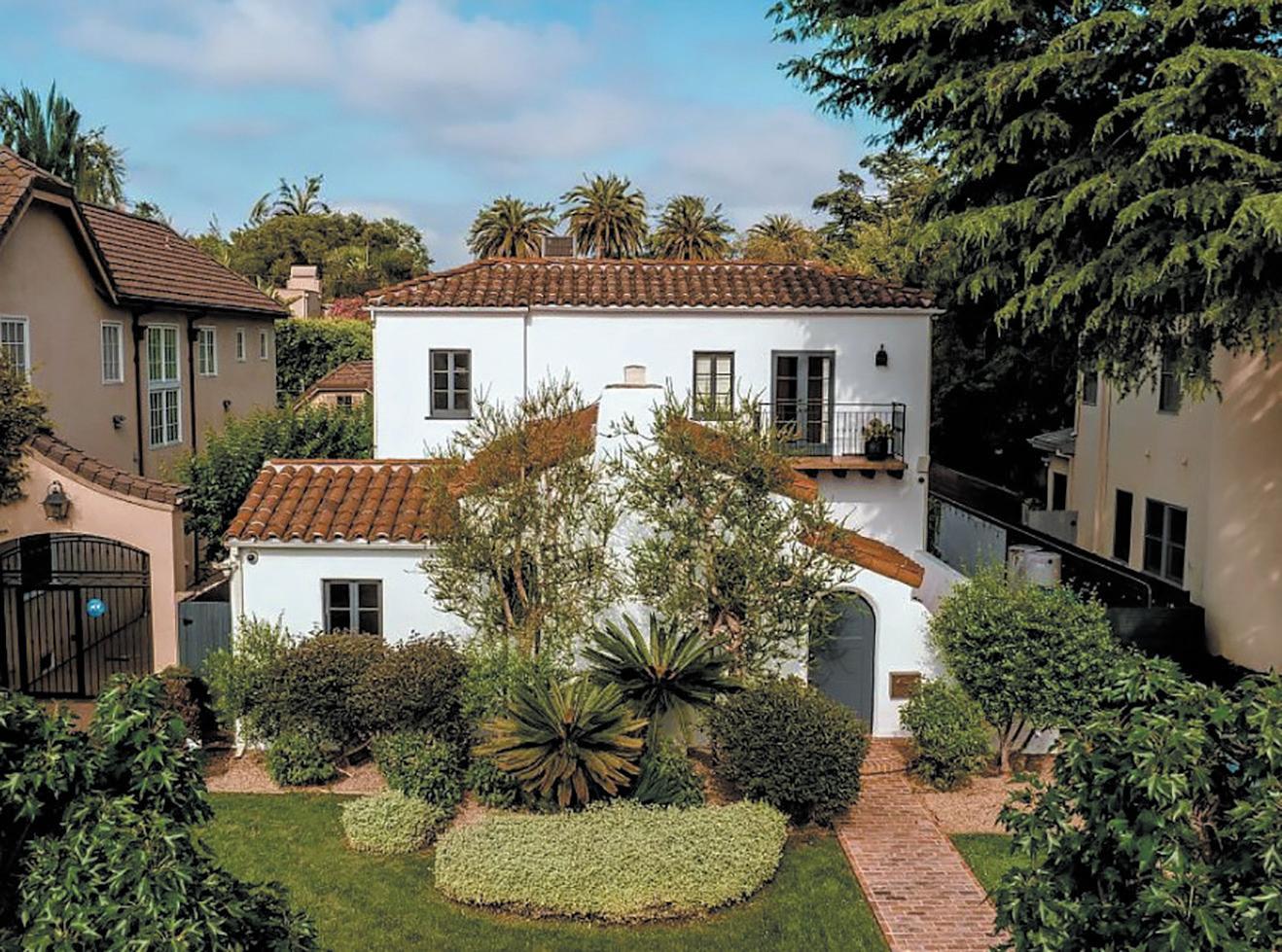





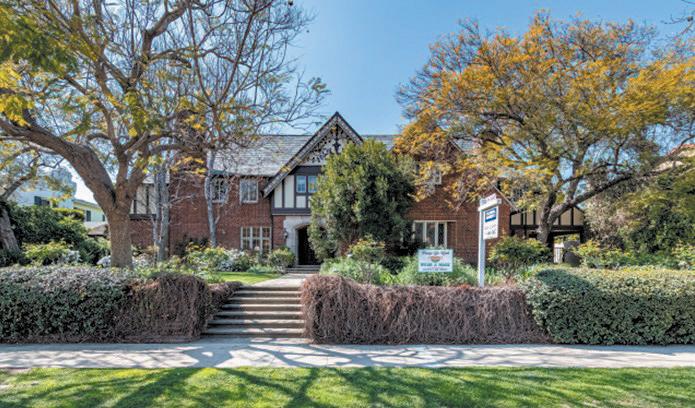







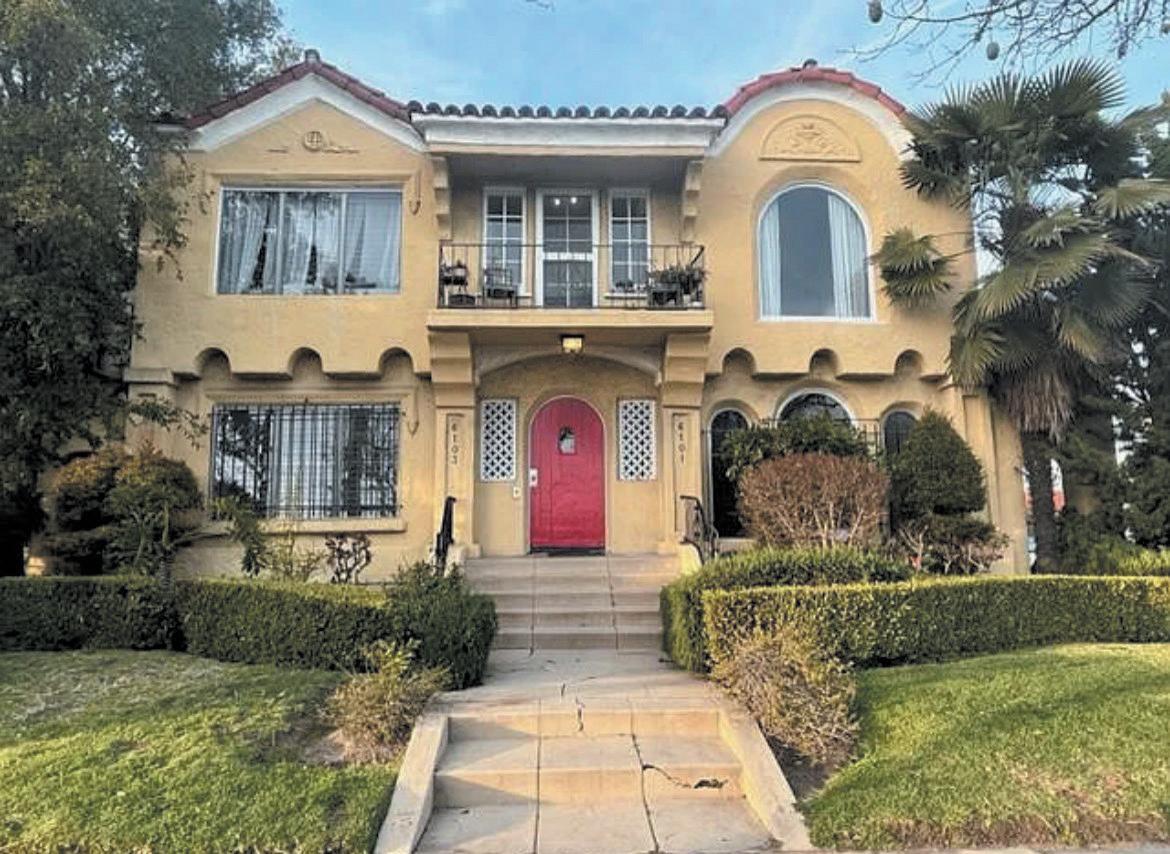


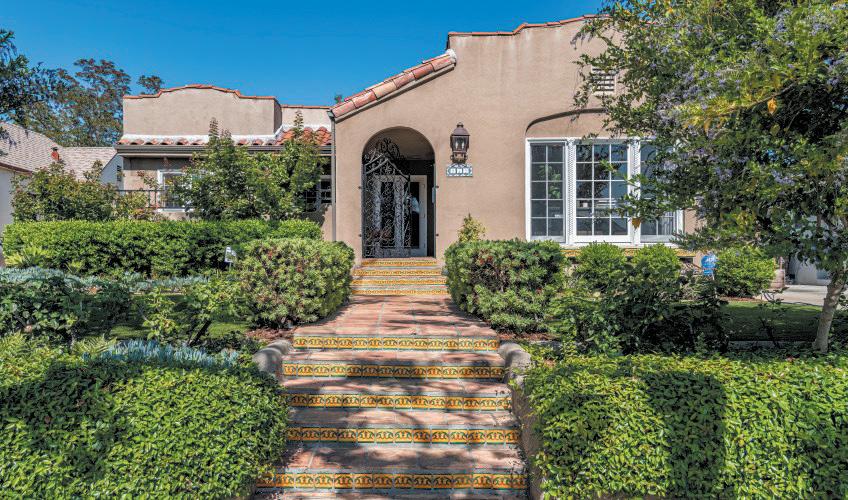


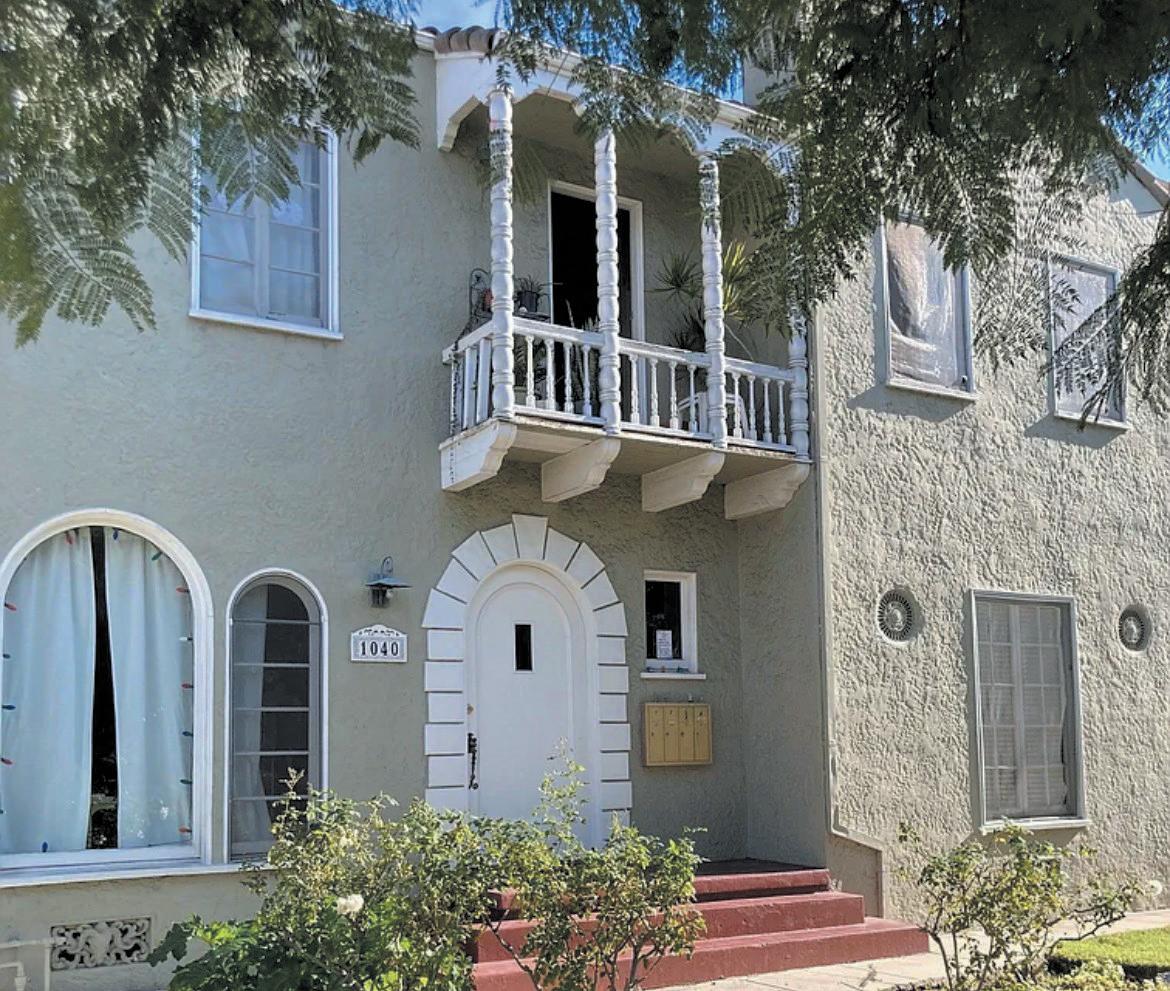





16 SECTION TWO SEPTEMBER 2023 Larchmont Chronicle 120 NORTH IRVING BOULEVARD ǀ $3,968,645 REPRESENTED THE BUYERS BEAUTIFUL FULLY REMODELED SPANISH IN PRIME WINDSOR SQUARE 4 BEDS + 3 BATHS + POOL SOLD LEASED 160 N. MCCADDEN PLACE ǀ $16,900/MO. SHORT/LONG-TERM ǀ FURNISHED/UNFURNISHED 5 BED + 6 BATH INCLUDING GH + POOL FOR LEASE 145 S. HUDSON AVE. ǀ $25,000/MO. SHORT/LONG-TERM ǀ FURNISHED/UNFURNISHED 6 BED + 7 BATHS + POOL + GH FALL INTO YOUR DREAM HOME THIS AUTUMN C: 323.206.0280 KRISTEN.TOSTADO@CBREALTY.COM @HANCOCKPARKHOMES CALRE#02203805 C: 323.810.0828 O: 323.460.7617 RLLANOS@COLDWELLBANKER.COM @HANCOCKPARKHOMES CALRE#01123101 1224 SOUTH CITRUS AVE. ǀ $5,000/MO. 3 BED + 2 BATH SPACI OUS DUPLEX LEASED IN ONE WEEK 6101 ALCOTT STREET ǀ $2,950/MO. 2 BED + 1 BATH, UPPER UNIT LEASED IN ONE WEEK LEASED IN ONE WEEK 412 SOUTH CITRUS AVE. ǀ $8,500/MO. CHARACTER SPANISH ǀ STUNNING UPGRADES 3 BED + 3 BATH + CONVERTED GARAGE 1040 S. CLOVERDALE AVE. #4 ǀ $3,300/MO. 2 BED + 1 BATH , REDONE KITCHEN & BATHS LEASED IN ONE WEEK FOR LEASE 449 N. HIGHLAND AVE. ǀ CALL FOR PRICE 4 BED + 3.5 BATH + POOL + FULL OF CHARAC TER COMING SOON! REMEMBER, WE CAN HELP YOU WITH ALL OF YOUR LEASING NEEDS AS WELL... EAT LOCAL & ENJOY YOUR NEIGHBORS AT HOPE NET’S “TASTE OF LARCHMONT” ON 9/18!


































 PERINO’S RESTAURANT circa 2004.
PERINO’S RESTAURANT circa 2004.





 By Suzan Filipek
By Suzan Filipek







































 By Helene Seifer
By Helene Seifer





















































